








A favourite Devon event that attracts hundreds of visitors is back this June – the Secret Gardens of Topsham, returning after a five-year absence due to the Covid pandemic.

Organised by the Topsham Museum, the secret gardens will open on Sunday 11th June. Normally the event is held in alternate years. Twelve private gardens, hidden gems in the town, will be on show from noon until 6pm.
“It is a wonderful day for garden lovers of course, but it’s also an event for the entire family who can explore the hidden paths and waterside walks of Topsham,” explained Rachel Nichols, who as president of Topsham Museum is leading this year’s event, and was one of the organisers of the first Secret Gardens day in 2004.
“Like all our Museum activities, this event is undertaken entirely by volunteers who have been planning it since last year, not to mention the garden owners who take huge pride in displaying their beautiful plants and gardens.”
Tea and homemade cakes will be available at two of the gardens, and there will be a plant stall at the Museum’s waterside garden. Entrance by programme at £8 will be available to order online via Topsham Museum e-shop, or from 8th May from the Museum, the Topsham Bookshop or the Wilkinson Grant estate agency branch in the town.
All proceeds from the event will go towards the running of Topsham Museum which has its main building in one of the 17th century houses on Strand, close to the River Exe, and which also has displays in a restored red phone box in the town centre.
For more details contact Rachel Nichols on info@topshammuseum.org.uk
You can create a beautiful dried flower crown at RHS Garden Rosemoor, perfect for the finest coronation celebrations.



The weekend of Saturday, 22nd April and Sunday, 23rd April sees RHS Garden Rosemoor host the garden’s National Rhododendron Show which has more than 60 classes covering all types of rhododendrons, trade and advice stalls plus magnificent displays of magnolias and camellias. Exhibitors arrive at the north Devon venue from all over the south and west. Competitions are free to enter and show schedules can be requested by emailing RHS Show Competition manager Georgina Barter at georginabarter@rhs.org.uk. The event opens at 11.30 am on Saturday after judging.
RHS Garden Rosemoor, Torrington, Devon EX38 8PH
During the half-day session, on Sunday, 16th April from 10.15am to 1pm or 2.15pm to 5pm you will create a beautiful dried flower crown using a selection of dried flowers and foliage in a kit from Florence and Flowers. Learn and practise the basic floristry techniques of taping and wiring, then start to build up your floral crown from the dried flowers and grasses.
Tea/coffee and cake are included. Normal garden admission applies.
From the apple trees on arrival to the show stopping ornamental cherry trees in the garden, the spring blossom display at Coleton Fishacre is one of the garden’s highlights.

Up to 30th April, visitors can pick up a free blossom spotter sheet and try to identifying the different trees at Coleton Fishacre, discover why the property is on a mission to bring blossom back and how you can help.
Coleton Fishacre is encouraging visitors to switch off and take a moment to slow down and enjoy the signs of new life. Connecting with nature, even for a few minutes, can give us an escape from the stresses of daily life and give us the space to gather our thoughts.
You could take photos of new blooms, have a picnic under the blossom, practise mindfulness or forest bathing. Join in and share your photos on social media using #BlossomWatch.
Coleton Fishacre, Brownstone Road, Kingswear, Dartmouth TQ6 0EQ
Fast Rabbit Farm which occupies 43 acres of informal gardens in the secluded Strawberry Valley in south Devon is opening its doors again this spring and summer for guided tours. The garden has the support of local naturalist Peter Shaw who has conducted several walks in previous years. This year the focus is on schools and the environment wildlife-oriented societies. If you are interested in taking along a party call 07791 011347. Fast Rabbit Farm lies just off the A3122 one mile from Dartmouth.
Fast Rabbit Farm, Strawberry Valley TQ6 0NB
Marwood Hill Gardens near Barnstaple has opened for a new season as a home to now four National Plant Collections which were looked after in association with Plant Heritage. The collections now include award winning astilbes, tulbaghia, Iris ensata and the gardens’ own Marwood Hill Garden Heritage Collection which is the result of 70 years of plant cultivation many of which are unique to Marwood and were selected, bred raised or gifted to the garden. The gardens are open through to October between 10am and 4.30pm but closed Mondays and Tuesdays.
Marwood Hill Gardens, Marwood, Barnstaple EX31 4EA
‘April has put a spirit of youth into everything’ - Shakespeare
‘When March goes on forever, And April’s twice as long, Who gives a damn if spring has come, As long as winter’s gone.’
- R. L. Ruzicka

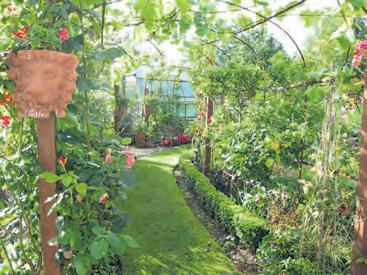
Growers Organics, a small family run business growing and selling organic vegetable plants in South Devon is celebrating their 20th year anniversary. It is an exciting time for the knowledgeable and dedicated team. With the increasing popularity of growing your own vegetables, Growers Organics has become a hub of the community not just in Yealmpton but the whole of the Southwest.
They have found their growing customer base to be very concerned about what they are eating and where it is coming from. It is important to them to work with the local wildlife, whilst using the space to grow edible plants for them and their families.
You can visit the Growers Organics Nursery in Yealmpton, Devon PL8 2LT, and see for yourself the quality of the plants. You can choose from over 100 varieties of vegetable plants, edible flowers, seed potatoes and onion sets. If you are unable to visit them, you can order plants online by visiting www.growersorganics.com
You can find Growers Organics regularly at Totnes Market, every Friday and Saturday as well as many plant fairs, including Toby’s Garden Festival at Powderham Castle, near Exeter on Friday 28th and Saturday 29th April.
Bow Garden & Aquatic
Centre are celebrating Pond Month with new Koi and pond fish, alongside friendly knowledgeable advice from their aquatics team. Bow also have all you need for indoor fish-keeping, with a selection of tropical, marine and coldwater fish, plus aquariums. Ponds are fantastic sources of wildlife and Bow have everything to maintain your existing pond or help you create a new one. Adding pond plants to your pond will attract wildlife, such as birds, butterflies, frogs, and newts. Floating plant baskets are on offer too – they are ideal for adding coverage and shelter for fish.
If you don’t have a pond but would like to add a touch of water to your garden Bow have a range of pre-formed ponds, and pond liners, making it easy to install a fish or wildlife pond as well as hundreds of water features, including solar options, so now is the perfect time to add some water and wildlife to your garden! Make the most of your pond and relax pondside with Bow’s new biggest range of garden furniture.

While you’re visiting, relax in Bow’s Waterside Café and enjoy home-made food made with local Devon produce.
You can also take advantage of Bow’s fresh new stock of fish and get ten per-cent off all Koi & pond fish by showing the team this article at the till (discount not to be used in conjunction with any other offer/voucher, one discount per customer per transaction, article to be surrendered in store for redemption, available whilst stocks last, valid 2023 only).
Bow Garden & Aquatic Centre is on the A3072 halfway between Crediton & Okehampton, just outside the village of Bow. Tel: 01363 82438 www.bowgardencentre.co.uk

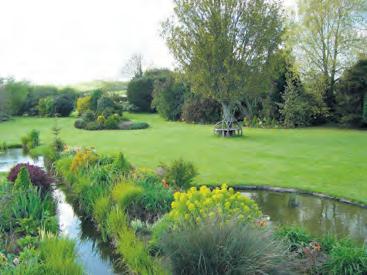


Beautiful and varied gardens are opening Devon for the National Garden Scheme over Easter –Andrew’s Corner at Belstone, Byes Reach at Sidmouth and Kia-Ora Farm and Gardens at Cullompton.
The tranquil moorland garden at ANDREW’S CORNER, Skaigh Lane, Belstone EX20 1RD celebrates its 52nd year of opening when it opens for the NGS on Easter Sunday 9th April, Easter Monday 10th April, from 2pm until 5pm each open day.
Magnolias, trillium and erythroniums are the highlights in April – the gardens also open on Sundays 16th and 30th April, and again in May when maples, rhododendrons, and then cornus, davidia and spectacular blue poppies take central stage. Admission £5, children free, homemade teas, plants for sale, wheelchair access, and dogs allowed. For more details of openings and the chance to book for a visit (for the NGS) arranged with the owner, go to www.andrewscorner.garden
In contrast, BYES REACH at 26 Coulsdon Road, Sidmouth EX109JP is a quarter of an acre garden with a colour-themed hot border at the front, going on to a potager-style vegetable garden with raised beds, seasonal colour-themed beds, studio and greenhouse, 20 metre fruit arched walkway, rill, pond, rockery and hostas collection. The garden is open from 1.30pm until 5pm. Admission is £3, children free, homemade teas with gluten free options, plants for sale, wheelchair access, dogs allowed and coaches welcome. Visits for the NGS by arrangement with the owners are available between May and September for groups of five to 20; contact on 07767 773374 or email latalbot01@gmail.com
KIA-ORA FARM & GARDENS at Knowle Lane, Cullompton EX15 1PZ is a favourite venue with visitors and regularly opens for the National Garden Scheme; this season the ten-acre garden with its lawns, lakes and ponds, swans, ducks and other wildlife, mature trees, shrubs, borders and rockeries, starts with Easter Sunday 9th April and Easter Monday 10th April, from 2pm until 5.30pm each open day. Admission £4, children free, homemade teas available, wheelchair access and coaches welcome.
The garden will open on Sundays 23rd and 30th April, and on several dates after that, and is also open by arrangement for the NGS from April until September. For more information on this and on the many other Devon gardens opening for the NGS which raises much needed funds for nursing and caring charities, go to www.ngs.org.uk and follow the links.
Toby’s Garden Festival, hosted by BBC gardening presenter Toby Buckland, is throwing open the gates at Powderham Castle, Kenton near Exeter for their 9th event on Friday, 28th and Saturday 29th April with over 175 exhibitors.
It’s an unmissable two days for gardeners and foodies, with a high quality range of stalls including award-winning Chelsea Flower Show plant nurseries, and a colourful array of roses, clematis and climbers, trees and shrubs, house plants and herbs.
This year’s celebrity speaker is BBC Gardener’s World presenter and garden designer, Joe Swift, who will be sharing his tips on getting the most from your garden in the Speaker’s Marquee. It’s one of three speaker programmes, where you can hear talks and demos on a range of topics, including flower farming, keeping chickens, planting a wildflower meadow and growing organic fruit and veggies.
There’s also a huge Artisan Barn, fill to the brim with quality local art and crafts, from handmade jewellery and soap, to landscape photography, knitwear and accessories.
Other attractions include stone balancing, book signings, outdoor kitchen tastings, tree climbing, stilt walkers, a miniature steam railway, heritage wood crafts and animals, including alpaca and chickens. Plus, you can make your own flower crown to wear at the festival with help from the British Academy of Flower Arts.
Head to Feast Street to grab a bite from one of 15 curated local street food producers and enjoy lunch sitting in the sunshine by the castle lake while listening to live music from talented local musicians.
New for 2023 is the Food Drink Devon Market showcasing a cornucopia of local producers, with talks and tastings on wine, cider, cheese and more. The talks are hosted by The Daily Telegraph’s wine guru, Susy Atkins, and food writer Mark Diacono of Otter Farm.

If you really want to make a day of it, upgrade your visit with a VIP ticket which grants all-day access to the 14th century castle’s stunning Music Room (as featured in the Anothony Hopkins movie Remains of the Day) with morning coffee and cake, a buffet lunch and afternoon tea, with a glass or two of fizz.
Next door in the Castle Dining Room, local wine merchant Wickham will be offering visitors a chance to try and buy a range of wine, from vineyards in Devon, England and abroad.
Tickets from £13.50 in advance, (children under 16 free except VIP tickets); dogs on leads welcome. www.tobygardenfest.co.uk
A total of 200 communities including five from Devon are making their neighbourhood a little wilder as part of the Nextdoor Nature Project, an initiative from the Wildlife Trusts supported by the National Lottery. More details at www.wildlifetrusts.org/nextdoor-nature
The Wildlife Trusts and Royal Horticultural Society (RHS) are calling on Devon gardeners to reimagine their lawns this summer as they launch their ‘Bring your lawn to life’ initiative.
The charities are encouraging gardeners to experiment with a new look lawn in this year for the benefit of wildlife and also the wider environment. They are inviting people to raise the blade on their mower and cut their grass less regularly, embrace daisies, dandelions, clovers and other naturally flowering plants, and even grow container lawns if space is at a premium.
Lawns left to grow long are shown to help mitigate flooding by better soaking up rainwater, counter the heat island effect in urban areas through their cooling properties, and capture pollutants. This means that their benefits continue into the height of summer, and provide all-important habitat for a whole host of insects including ants, bees and butterflies.
Five ways to love your lawn this year:
• Reduce the frequency of mowing to once every three to four weeks to allow flowers such as dandelion and speedwell to bloom and help pollinators.
• Keep some areas short as pathways, sunbathing spots, and foraging areas for worm-eating birds. For the rest, let the grass grow a little longer, offering shelter to grasshoppers and other insects. In turn, these creatures are food for frogs, birds, and bats.
• Allow parts of your lawn to grow long for the whole summer so that caterpillars can feed and transform into butterflies and moths.
• Turn a blind eye to the odd bare patch within a lawn as these provide sites for ground nesting bees.
• If you do want a luscious green carpet, consider growing hardy yarrow within your lawn or, where there is limited footfall, experiment with a tapestry lawn and grow herbs and flowers such as chamomile and creeping thyme.
Expect to see fewer birds in your garden if you use weedkillers. Research carried out in Dorset, Devon and Hampshire by University of Sussex scientists found gardeners used pesticides in about a third of the gardens they investigated.
House sparrow, great tit and robin populations were all significantly lower where glyphosate was used.
We are delighted to continue a new gardening season with a more in-depth Time Off section as more garden clubs return to a full activity schedule. If your club would like Country Gardener to carry details of your club or societies’ activities then either email us at editorial@countrygardener.co.uk or send details to Time Off, Mount House, Halse, Taunton TA4 3AD
April
25TH
Crediton Garden Club
‘THE GARDENS AND PLANTS OF MADEIRA’ - SAUL WALKER
27TH
Exmouth Garden Club
‘WOODLAND GARDEN PLANTS’ - JESSICA EVANS
Details on 01395 263513
3RD
Brigham Horticultural Society
MONTHLY MEETING
Details on 01803 842121
15TH
Meavy Garden Society
‘TAMAR VALLEY CROCOSMIA & OTHER SOUTH AFRICAN GEMS’ - MARK WASH
Details on 01822 852672
16TH
Bickleigh, Roborough & District Garden Society
‘WOOLWELL IN BLOOM’
- SORAYA LEWIS-COLEMAN
17TH
Torquay & District Garden Club
‘HOSTAS’ - PETER SAVAGE
Email: nickibaker222@gmail.com
20TH
Chulmleigh & District Garden Society
COFFEE MORNING & PLANT SALE
Details om 01769 580719
25TH
Exmouth Garden Club
‘FRAGRANCE N THE GARDEN’
- JENNY SHORT
Details on 01395 263513










There’s huge pleasure in adjusting our gardens to attract as much wildlife as possible and there’s another pleasure to be archived by knowing that our specific action has been noted and acted upon by wildlife. To do all this you don’t need to stop gardening and your plot doesn’t have to become a bramble filled wilderness, nor do you need acres of land.
Even on a tiny patch on a windowsill or on a balcony we can do our bit this season to make our own personal space more attractive to the natural world and to us.
Gardening without chemicals is a good way to ensure that the food and plants you grow are free of pesticides or chemicals, thriving without the extra expense of dangerous products that are harmful to our wildlife. If you’ve used chemicals in the past, this might sound like an invitation to every insect from miles around to chomp its way through your garden. But, with time and patience, you’ll end up with a rewarding, healthier garden for ditching the chemicals.
Spraying to deal with minibeasts can often kill the animals that eat them too, or at least make them avoid your garden. When you stop using chemicals, aphids are the first creatures to return as they have a short breeding cycle. Their predators may take longer to come back but stick with it and know it will be better in the long run!
birds will already be prospecting for nesting sites which should be a couple of metres above ground level and facing away from prevailing winds.
in on the water and it’s also a wonderful insight into what can be grown in terms of water plants.
It is no coincidence that gardens which seem to be awash with wildlife have a range of berry shrubs in them. Plant bearing shrubs ensure that garden birds have a natural source of food throughout the winter. So, although you may lose a few berries to the birds it’s a sacrifice worth making.
Bird feeders are now an all year-round occurrence in our gardens and rightly so. Wash and clean your feeders every couple of weeks as there has been a recurrence of diseases spreading from ones that are not clean. And make sure that fresh water is always available.
It wasn’t too long ago when having a logpile in your garden was considered slightly odd and unnecessary. Now they seem to be a must have for those gardeners keen to attract wildlife. It’s worth remembering that 90 per-cent of garden wildlife is invisible. A pile of rotting twigs, tree trunks and branches and you will soon find it supporting a rich and varied range of creatures which rely on decay to fuel their lifestyle.

Plan a wildflower patch in your garden. No, it doesn’t have to be a large area. It can just be a corner of a border or lawn. If you have the space, then an entire meadow planted out with wildflowers is a wonderful thing. You can still have a lawn but a patch somewhere where vetches and clover, cowslips and moon daisies are allowed to grow will not only significantly increase the number of bees and butterflies that visit your garden but look beautiful as well. You can sow a wildflower seed mixture but remember to check which one will suit your soil type and situation or plant wildflower plugs in an existing lawn. Don’t try and sow wildflowers on an existing lawn as they will be swamped by the grass. Cut wildflower patches in early September when the seeds have fallen and rake off the hay.


Put up nest boxes so that birds can not only use them to raise their young but also as roosts in winter. Wrens and other small birds will crowd into nest boxes just to keep warm but in March blue tits, robins and other small
A garden pond does so many things for wildlife. It encourages birds to drink, frogs to spawn and newts to be part of our garden world. The larger the pond the better but even a small one will offer a refuge. Make the sides gently sloping so that creatures can approach the water for a drink and then get out of the water with ease. Anyone with a pond always marvels how wildlife homes

Grow plenty of single flowers for pollinating insects. The double flowers will of course brighten your garden but remember that single flowers have pollen and many fully double flowers do not, which means they attract more butterflies, bees and other pollinators. Pollinators are essential for fruit trees and for bushes and in fact for many vegetable crops so planting a few pollen rich single flowers will attract these beneficial insects and you will have the added bonus of being able to cut a few for the house as well.
Have a patch of nettles in a sunny spot to attract butterflies in search of egg laying sites. You may not love nettles but many little creatures lay their eggs on nettles, such as the Red Admiral, Small Tortoiseshell, Peacock and Comma butterflies all lay their eggs on stinging nettles - and they prefer the plants to be in the sun! Although Red Admirals are a common sight in the British countryside, they are in fact a seasonal migrant and can be seen as early as March. The females lay single eggs on the upper leaves of nettles, usually in the middle of large swathes of plants. The caterpillars emerge after seven days and immediately begin folding nettle leaves into safety tents.
The nettles themselves support over 40 different kinds of insects. The insects, which use the nettle sting as a shield, provide food for ladybirds. Aphids on nettles provide food for blue tits and other woodland birds.
















The start of a new gardening season has brought with it a lively response from Country Gardener readers. If you have any views, ideas, or gardening thoughts to share with us then write to us at Have Your Say, Country Gardener, Mount House, Halse, Taunton, Somerset TA4 3AD or email editorial@countrygardener.co.uk
I have just completed a three-month wrangle on what I am allowed to grow on my Devon allotment. It seems the terms held by the allotment society stipulate that I must only grow produce. I thought this should act as a bit of a warning for other allotment holders. I received a delegation last year when it became clear I was growing flowers and that I was temporarily using my land as a home for a National Plant Collection while my garden was sorted out. I have finally won but what a battle it was!
The National Allotment Society told me they constantly advise allotment holders to check their agreement because as they say ‘there are some weird rules and regulations which have been allowed to sneak in’.
Mark Norton Exeter
I wonder if your readers are fully aware of just how serious the current outbreak of bird flu is. Here in Devon, robins, sparrows and finches seem to be the worst affected. I sit on an RSPB local committee and one thing we have been urging those who love to have birds in their gardens to do is to double down when it comes to cleaning bird feeders. Within the RSPB the view is that if we all really scrubbed and cleaned bird feeders once a week it would have a huge impact on the spread of this disease.
There is no need to stop feeding. Birds get such help from food through the spring so it’s perfectly OK to keep going.
Anna Marshall DawlishI rarely write to gardening magazines, but I am doing so out of happiness that something has been done about one of my pet gardening hates- artificial grass. I have been a member of the RHS for 15 years now and before Christmas I read that the society had taken the decision to ban fake, artificial grass, believing it to be sterile, lifeless and a problem for the environment.
A few years ago this artificial grass seemed to be going through something of a boom period and it started being offered all over the place and used by landscape gardeners. Thankfully the RHS has acted correctly and it’s a further success for nature.
 Giles Adamson Portsmouth
Giles Adamson Portsmouth
I have started to place my orchids in the shower cubicle after I have finished taking a shower. The steamy atmosphere has done wonders for my plants. After about an hour I return them to their normal home of the windowsill. They are full of new blooms and have bright, healthy-looking leaves.
 Maggie Harrison Liss
Maggie Harrison Liss
The land in front of our house does not belong to us but to the local council who after we had approached them gave us permission to plant spring bulbs. This was 12 years ago and in that first year we planted 500 bulbs and have added roughly 100 more every year filling in the gaps and trying to have a continuous display of flowers in bloom for several months. Passers by love the display and we have had so many comments and appreciation. One family has even taught their children the names of the flowers. I would encourage anyone who can do the same to try this out. The council should be both keen and helpful and it is amazing how many new friends you will make just having flowers around.
Janice Curtis CheltenhamWe pride ourselves of using every spare bit of plastic bottles in our garden. We cut them into three sections. The bottom as pots for cuttings; the middle section protects plants from slugs and the top is popped on to canes to act as a protector against accidents. Nothing is wasted down here in Dorset!
Peter Christie Dorchester
I totally agree with the view now being promised that we need our hospitals to do more when it comes to gardens. I am not suggesting for a minute that NHS funds be diverted into horticulture but what is needed is a coordinated plan of volunteers and sponsors to see what is possible to help people who have to go through the traumas of a hospital visits and stays. I recently attended a cardiology unit in a busy city centre hospital which has a garden annexed to the waiting room. On a lovely spring morning to say it lifted the spirits of everyone there was an understatement. Peace and tranquillity is what we all need when tied to hospitals and I am sure more can be done.
Maureen Graham Exeter
I have just read an article that begonias are out of fashion and Britain in Bloom judges have urged gardeners not to make use of them in their displays. They say they want to see ‘more sustainable' new perennial plants. I feel someone should make a stand for the good old begonia which has always been a favourite of mine. Nothing in my opinion comes easier than growing begonias, no pests, no deadheading and up to nine months of flowers, and while they may not be the most pollen friendly of flowers they surely still have a role to play as colourful, simple and insect friendly perennials.
Jacquie Preston Oxford

Why would a gardener want to bury pennies with their plants? This came up during a talk to our gardening club by a remarkable 80 year old who was full of gardening myths and tales and he claimed its because pennies contain copper, and copper is a fungicide. If untreated, fungus can cause plant damage and inhibit growth. When mixed with the soil, the metal from the penny helps kill fungal spores in the soil. No, I am not sure either!
Tessa Greene MineheadI have read that many land workers were working so hard that Good Friday was the only day between New Year and Easter that they had free to get into their garden to start planting. My dad always used to wait until Good Friday and made a fuss about that being the right day to get his main crop in. I always thought it was a religious thing but nothing so romantic! Catholics planted potatoes on Good Friday in order to make them holy – and therefore OK to eat - and some stories add that the seed potatoes were sprinkled with holy water before being planted.
Bryan Holliday OkehamptonIf you would like to advertise your business or service in our Devon magazine, please contact cath.pettyfer@countrygardener.co.uk Tel: 01837 82660














DON’T


“Picked up a copy of your September issue yesterday. I have to say that it was easily the best free magazine of its type I have ever read. Congratulations on such a great publication.”
JUST TAKE OUR WORD...
Mushroom compost, ornamental bark and wood chip £3 small bag £85 dumpy bag
Compost, topsoil farmyard manure, horse manure, wood chip mulch and chicken manure
£2.50 small bag £75 dumpy bag
Bulk orders can be mixed
Example 1/3 topsoil 1/3 manure 1/3 compost
Great for raised beds
Topsoil and compost is sieved or screened producing a lump free stone free product





Heather: 07809 870230 | Nick: 07860 459745
The Farm: 01404 891684 | Evenings: 01884 841694
www.connetts.co.uk | connettsfarm@outlook.com

Connetts Farm Connetts Farm

Delivery available at cost
For the latest garden news, events & advice - don't miss COUNTRY GARDENER

www.countrygardener.co.uk

David Jarvis has been growing strawberries in Dorset for more than 20 years and his whole philosophy is based on doing everything from the choice of varieties to the way they are grown to focus on the sweetest fruit imaginable
The one priority all gardeners should have when growing strawberries is flavour and sweetness.

We all crave that sugary sublime sweetness that comes from the perfect berry, it’s what we all set out to achieve. There aren’t many of us that appreciate tart strawberries – maybe if you’re making jams or cooking with them, but not to eat fresh.
And it isn’t, as you might assume, all down to variety either.
True, some varieties taste better than others, and true, some naturally have more sweetness. But variety choice isn’t the only factor involved here – cultivation plays a big part.
So, in order to harvest the perfect, sweetest strawberry, you need to make sure a few factors come together.
You can make a poorly tasting variety more palatable by employing these growing techniques, but it may never attain perfection.
You can similarly grow the best tasting variety in the world but if it is cultivated poorly it will still disappoint.
So, you need a combination of these varieties, I have selected and the growing hints is your ticket to strawberry tasting heaven!
Almost inevitably the older varieties predominate here, showing the gap in class when it comes to a stringent taste-test such as this. But a few modern varieties do make the list too.

The best tasting ones come from those in the natural soil – plants grown in pots of standard proprietary potting compost yield berries that are inferior in taste. Which is not to say you should not grow and enjoy strawberries in containers –still better than those you might buy from the supermarket but if you want the perfect strawberry try to grow them in the ground. Potting compost seems to make the fruits ‘sharp’ and lacking in the rosy roundness of well flavoured fruits.
Plants must never even think of drying out. This is especially important if you have been able to give the plants a position with maximum sun exposure. You must counteract this with regular and ample watering. Soak the soil around the base of the plant with a watering can, early in the morning.
You will want to feed your strawberries in order to help the plants develop the flavour; starving plants, even if they may look healthy enough, will not yield well flavoured fruits. The choice of fertiliser is key – you want one with lots of potassium because it has been proven that plants fed with a potassium rich feed develop more sugar and a better flavour! Tomato feed [Tomorite or similar] is the most well-known fertiliser, it’s easy to find and use.
You’ve done all the hard work, so to experience your strawberries at their absolute best you need to understand what is the optimum time to savour them. If you pick too soon the flavour still won’t have developed to its absolute peak. The berries may be colouring up but if they are too pale or not coloured evenly then it is too soon. They may still be a little sour. Conversely, berries that have been hanging on the plant for too long and become too dark will have a flavour that has become wine-like, overbaked.
How many times a year do strawberries fruit?
How often strawberry plants produce fruit in a growing season depends on the type of strawberry. There are exceptions, but, generally: classic strawberries fruit once a year in early summer. Perpetual or ever-bearing strawberries fruit in early summer and a smaller crop in early autumn.





What time of year do you plant strawberries?
Strawberry plants can be planted any time the ground is not frozen.
Do strawberries need bees?
Strawberries are self-pollinating but do benefit with assistance from insects including bees and the wind. For this reason, the plants should never be covered with protective netting until pollination has taken place.
Do you cut back strawberries for winter?
It is not necessary to cut back strawberries for winter, leave dead growth in place for added insulation during colder seasons. In spring, any dead foliage can be removed.
Can you grow strawberries inside year-round?

It is possible to grow strawberries indoors year-round in greenhouse conditions. This is much more challenging due to fluctuating conditions caused by heating and cooling systems, varying light conditions, and drafts. Some gardeners grow alpine strawberries indoors although they grow very slowly.

Strawberry ‘Christine’
The large, glossy and flavoursome fruits of ‘Christine’ make this a popular variety to grow. An early strawberry, it also possesses good disease resistance.
Strawberry ‘Gariguette’
Strawberry ‘Gariguette’ has long, elongated fruits and a wonderful flavour that is reminiscent of alpine strawberries.


Strawberry ‘Hapil’
This reliable mid-season variety will produce a good crop of large fruits, even on poor, drier soils. The fruits are firm and have an excellent, sweet flavour – perfect for jam.
Strawberry ‘Cambridge Favourite’
‘Cambridge Favourite’ is one of the best known and most popular strawberry varieties. It reliably produces medium-sized, orange-red berries with a good flavour.
Strawberry ‘Buddy’
‘Buddy’ is a newer, everbearing variety with very sweet fruits on plants with good disease-resistance and weather tolerance. Unlike many other everbearing varieties, this one is a heavy cropper.
Strawberry ‘Finesse’
‘Finesse’ is an everbearing variety with good resistance to the diseases that can affect strawberries, such as verticillium wilt. It produces lots of tasty, heart-shaped fruits from July to September.
Strawberry ‘Fenella’
Bred in England, ‘Fenella’ is a modern variety. Its large berries stand up well to heavy rain and the plant is also resistant to verticillium wilt and crown rot. It has an upright growth habit.
Strawberry ‘Symphony’
Symphony’ was bred in Scotland and does well in damper conditions. It grows well in the west country. It produces glossy, tasty, medium to large berries.
Strawberry ‘Mara des Bois’
‘Mara des Bois’ has the flavour of an alpine strawberry but the size of a traditional strawberry and fruits from mid-August to mid-October. It’s resistant to powdery mildew.

“..but if you want the perfect strawberry try to grow them in the ground.”
Being an enthusiastic horticulturist, it’s only fitting that Dawn Schier unearthed the power of the plant world when looking for ways to keep her active so she could continue to enjoy her hobby.
“My interest in gardening was inherited from my father,” recounted Dawn.
“My dad had an allotment and it was there that I inherited his passion for growing fruit and vegetables. For our family, it became part of an everyday healthy lifestyle that we all enjoyed.”
Dawn began to have trouble continuing to garden when she noticed her knees were not as fl exible as they used to be, so she decided to do something about it. It was this decision that led her to Turmeric+ from FutureYou Cambridge. The spice turmeric has long
been popular in traditional Indian medicine and is recognised as one of nature’s superfoods.
The key active component of turmeric is curcumin. However curcumin is not easily absorbed by the body.
The need for easy absorption is what led the scientists at FutureYou Cambridge to create Turmeric+ using the patented ‘Curcuma Phospholipid Complex’ formulation. It’s thirty times more absorbable than standard turmeric and contains vitamins C and D which contribute to normal function of cartilage and normal muscle function.*


Dawn continues, “Although I eat a healthy diet and take plenty of exercise, I was finding even walking around the block caused discomfort. I decided I needed to find something else to provide a helping hand so I started taking Turmeric+.”
Just

FutureYou Cambridge are renowned for developing the highest quality health supplements backed by leading scientific research. The Cambridge-based company, who actively work with highly-regarded scientific and nutritional experts, is offering you the opportunity to try its bestselling joint supplement, Turmeric+, for free, for 28 days.*
Turmeric+ contains the most scientifically documented bioavailable curcumin formulation in existence, having been the focus of 45 human studies involving over 2,000 subjects. It has also been officially recognised and certified by Informed-Sport.
The patented curcuma phospholipid complex formulation features a
unique phytosome delivery system to significantly increase curcumin bioavailability; an advanced natural alternative to black pepper. Pharmacokinetics studies show it enhances curcumin absorption by 30 times.
The vegan-friendly formula contains the full bouquet of curcuminoids including high levels of demethoxycurcumin (DMC), the most powerful curcuminoid. It has also been combined with vitamin C which contributes to normal collagen formation for the normal function of cartilage.
‘We want to support more people to become or stay active. We think Turmeric+ can play an important role in that journey.
“I was amazed. In just a few weeks, I felt like I used to. It was the only change I made to my lifestyle, so there was no other explanation for the dramatic difference.”
Dawn is now able to fully enjoy her lifelong hobby to its full potential again, growing a wide variety of fruits and vegetables. Whilst she reaps the benefits
of all she grows, her favourite is asparagus. Dawn said, “I specialised in growing asparagus some while ago and the other allotment holders have nicknamed me the ‘Asparagus Queen’”.
“I love working on my allotment, it provides a good social life, but most importantly it’s where I feel completely relaxed and can enjoy some time to myself.”
‘We offer people their first pack of Turmeric+ for free so they can experience the high quality, patented curcumin formulation for themselves. Most will know if it’s working for them within four to eight weeks – and if they like it, they will stick with it.’ says Adam Cleevely, FutureYou Cambridge’s Chair.
‘I’ve been genuinely amazed by the effect of Turmeric+. It’s transformative. As far as I’m concerned, I’ll be taking it for the rest of my life.’ said James, 54, from London.

As every keen gardener knows, kneeling down is part and parcel of the job, so it’s essential to be able to comfortably bend your knees.
“I was amazed. In just a few weeks, I felt like I used to.”
We are a nation of tea drinkers, drinking an estimated 100 million cups daily. It is a habit that punctuates our day - from our wake-up brew to a comforting cuppa in times of need. And all from countries like China and India, several thousands miles away.
Or is it? Because while China and India have the monopoly on teagrowing, it is becoming increasingly possible to make your afternoon cup of tea with leaves grown here in the UK.
One such plantation is Dartmoor Estate Tea, a 14-acre farm on the outskirts of Ashburton in Devon, owned and run by Jo Harper and Kathryn Bennett. The couple produce award-winning black, green and yellow teas. This year they aim to make enough tea to make 10,000 cups.
It all started 15 years ago when Jo bought the property and land as a project to renovate and wanted to put the land to use. But starting to grow tea was not the most obvious choice of crop to grow in Devon - especially by a couple who, by their own admission, were poor gardeners.
“We had a plan to renovate the house and all the time knowing we wanted to do something with the land,” said Jo. “We had an idea of growing a crop but didn’t want to grow something like potatoes or hay that everybody else grows.
“I could see that you could get a bit of an income as a market gardener but as a beginner grower I couldn’t take on all those varieties. So if we were going to learn how to grow something I wanted to grow something that would be useful knowledge and try to be a bit innovative. This country didn’t need another person who knew how to grow strawberries!”
So they narrowed their choices down to four crops that could be grown outdoors in the UK - chickpeas, lentils, liquorice and tea. And, despite not being great tea drinkers, the nation’s favourite drink was the crop of choice.
One of the biggest problems the couple faced was the lack of knowledge and support for beginner tea growers.
“We started from scratch with absolutely no knowledge - there were no books on growing tea in the UK, only on how to grow tea in India and China, but the growing conditions and climate are very different to Devon.
“We couldn’t get any advice from the few fellow UK tea growers so we turned to You Tube and to other growers around the world, and eventually we started to draw people to us that had more knowledge.”
Being self-proclaimed horticultural and tea-drinking novices, the couple had a steep learning curve when they first started growing the crop.
“We bought some seeds and started growing them in the house, and then eventually transferred them to a small polytunnel where we could overwinter our seedlings before bringing them out when they were two years old.
“Originally we planted about 1,000 seeds but only got 367 plants from them but back then it took us a few years to even realise we needed to water them!”
Kathryn explained that when they started their knowledge of drinking tea was restricted to “tea-bag builders’ tea” and the odd cup of green tea which wasn’t to their taste.
She said: “Even though most of us drink tea every day most people don’t know much about where it comes from - we realised when we started how little we knew about one of the country’s favourite drinks.
“We needed to drink a lot of tea - and different types - to get to know how to gauge what we were growing, so we visited a lot of tea merchants and did lots of tasting.”
Between April and October the couple run tours of the plantation - their guests learning how tea is grown and produced before heading back to the tea-house to sample a cup of the prized drink.
They learn that all tea comes from the same plant - Camellia sinensis - and that it is the picking and processing of the leaves which determines the colour or type of tea it becomes.

Kathryn said: “Most of our visitors think that there are separate plants for say green tea, black tea or oolong but they are the same plants, it is just the processing that determines the type.”
Tea originated in China, around 5,000 years ago, and was originally used as medicine and flavourings before finding fame as a beverage.
It was introduced to the West in the 1600s by the Portuguese and Dutch. Until this time all tea had been green, but growers discovered that by altering the processing they could make black tea. This kept its flavour for longer and could withstand longer journeys. By the late 1600s the British were importing tea on a commercial scale.

With its origins so firmly rooted in Asia, it was a venture that was a risk for the Devon couple because the conditions and climate are so different to those in the East.
Jo said: “We have been lucky. Our soil is only just on the right side of acidic. Tea likes to have twice the amount of water than we get, about 40 per cent more UV light than we get, and a higher PH than we have. But while this all reduces the yield, it allows some very interesting flavours to come out.
“Some of the finest teas produced are as a result of it being stressed. So this means that while our yield will never be huge we produce a very good product with really good flavour that has been recognised nationally and internationally.”
To increase their knowledge of their craft, the couple last year travelled to India to visit plantations - substantially larger operations than their Devon farm.

“They laughed at us in India,” Jo said. “They were growing almost two million saplings compared to our 8,000.
“But we also noticed that the fertilisers they have used have really destroyed huge areas of the landscape and damaged the soil, so they are now coming round to using organic practices which is really good to see.”
Jo Harper and Kathryn Bennett’s 14-acre farm just outside Ashburton now produces award winning black, green and yellow teas. They started with no knowledge and little support so the learning curve has been a steep one.
The couple have always adopted organic principles on their plantation, making their own fertilisers from nettles, and are now exploring biodynamic preparations. They also have plans to create a wild area of the farm to let the bushes grow into trees.


“We have two acres planted to tea bushes, but it is actually a woodland plant - a tree - so our longterm vision is to grow some plants into trees. They can grow very high - there are up to 1,000 tea trees that have been registered as significant by UNESCO because they are over 1,000 years old.”
The production of the tea leaves is labour-intensive. It starts by picking the leaves - specifically two leaves and a bud - by hand. This is then weighed and put on drying racks which allows the moisture to evaporate.
Kathryn explained: “If you try to roll the fresh leaf it will just tear, so we dry it for about 25 hours to let it wither down.
“It is then rolled - usually by hand. This takes about an hour and is pretty labour intensive. The handling time for one batch is about 14 - 16 hours. Picking in the field takes six to eight hours and then the same time again of rolling the leaves.”
One kilogram of fresh leaf produces 200g of dried leaf - this makes around 70 cups of tea, of which each one can be used for multiple infusions.
Jo explained that learning abut drinking tea had also been a revelation: “We used to have a cup of tea from a tea bag and add milk. When our guests taste our black tea they always comment that you would not need to add any milk, or sugar, to it because it is so naturally sweet.
“We also learned that we were using the wrong temperature water for our tea - in fact black tea should be made with water that is about 95°C and green tea made with water about 85°C - this immediately stops it from tasting so bitter.”
When they serve tea to their visitors, they use a Chinese Gaiwan setdesigned to produce a uniformity of flavour.
“We don’t serve our tea like this to be pretentious,” Jo explained. “The Chinese call this ‘The Fairness Jug’ - if we were to pour it into three cups straight from the pot we would get a different flavour each time. Pouring it into the Gaiwan first, and then serving it in cups, creates a uniformed flavour for all the drinkers. Taking the water off the leaves also prevents any bitterness. This means we can use the same leaves but experience different flavours from each infusion.
“Tea bags are designed to have one hit. They are made with tiny flakes of tea, so the water can pull out the flavour fast. But leaves can be used for multiple infusions - rolling it, it keeps the flavours trapped in the leaves. So the more times you pour water on the same tea leaves the more it will unfurl and the more it will resemble the tea in the field.
“This way you experience different flavours at each infusion - if it is a good quality loose leaf tea you can definitely use it several times.”
While the plantation is a far cry from the industrial plantations of India and China, the Dartmoor farm is attracting a wide customer base across

the country, and are set to expand even further in coming years.
“Devon has allowed us to make good tea - we’ve had a lot of good fortune and as luck would have it, we chose the right crop for this location,” Jo said.
“When I was growing up in the ‘70s there were a few people growing vines in this country, and people laughed at those farmers who were trying to diversify, but now it is a multi-million pound industry.
“Who knows what’s going to happen in 30 year’s time with British teawe built this from scratch, it is a labour of love and we are now looking forward to more people enjoying our tea but also teaching people about how to grow their own.”
Maybe in years to come we will all be able to say we are drinking tea that we have grown in our gardens.
www.dartmoorestatetea.com

“We started from scratch with no knowledgethere were no books on growing tea in the UK, only on how to grow tea in India and China, but growing conditions and climate are very different to Devon.”
It’s the time of the year when we are all looking for something new, something colourful, something to add afresh to this year’s garden. So, we’ve looked at some of our favourite new and not so new things on the block
We all know that kale is a healthy food, and we all know we should eat more of it. But the taste is not usually sufficiently tempting, and kale plants don’t look especially beautiful when growing in the garden. Well, things are changing.
This is the world’s first edible ornamental that was released at the RHS Chelsea Flower Show two years ago and is stunning. The result is an F1 hybrid kale called ‘Rainbow Candy Crush’. It is a plant that reaches 40-50cm high and 40-60cm wide with a long harvest period, and vibrant colouring.

A terrific dwarf plant that has quickly won favour for its outstanding pot and garden performance. Its naturally compact, mounded habit makes it great choice for those wanting a wellshaped plant with little effort. It responds very well to a quick prune, that said, this is rarely required as its habit is naturally so dense and compact.

It prefers a full sun location for optimum results. Although naturally compact, you can prune to shape if desired after the flowering period.
Gingko are loved for their beautiful seasonal colour and this new release provides a stunning change of seasons display with lemon yellow foliage.
The rich lime-green delicately creased summer foliage will be a feature in large or small gardens and makes a beautiful potted specimen. Ginko are also known for the smelly fruit they can bear but this male clone won't produce them! With a strong vertical growth habit this is perfect for courtyard gardens, and containers. Lemonlime Spire is best planted in a position sheltered from severe north- westerly sun as well as hot and dry winds and will perform best in temperate climates with cool to cold winters.
This is a standout plant for those hard to plant shady areas.

'Mona Lavender' has become a hugely popular hybrid form
producing purple, two-lipped blooms open along a purple stem that juts out above glossy leaves that are green on the top side, purple on the undersides. This sturdy little tropical plant is easy to grow and will thrive with minimal care. The botanical name derives from two Greek words: ‘plectron,’ which means spur, and ‘anthos,’ which means flower. (Plectranthus plants are often known as spur flowers.)
Prunus ‘Kanzan’
This double pink flowered cherry is possibly the most wellknown of the Japanese cherries but even so a wonderful addition to any garden. It is an elegant, small, but wide growing tree with a vase-shaped crown which grows as wide as tall. It blooms with long stalked bunches of very pink flowers that open among the young leaves which are bronze-green.

It is vase-shaped when young, later spreading, with copperybrown young foliage and vivid purplish-pink double flowers five cms in width opening from crimson buds. Ornamental cherries grow best in full sun on moist fertile deep loamy soils, it is perfectly happy on alkaline soils which it prefers. It will therefore grow well in most gardens.

Hellebores are wonderfully varied when it comes to shades and styles ranging from pure white through to darkest plum. The secret is to try and raise them up off the ground so they show off their colours to the maximum.
Highly valued in milder regions, for their winter effect in the garden, this hybrid forms an upright clump of leathery, serrated, heavily silvered, blue-green leaves with outward facing, saucershaped creamy-green flowers that, on the outside, are mauve with a rose blush. Flowers appear in late winter and continue into spring. Avoid any pruning other than to remove dead leaves or stems down near the base of the plant. Clumps may be carefully divided after flowering in late spring every few years, if desired.
This is a wonderful scented pelargonium-'Prince of Orange' and a popular variety with a bushy habit and a very strong orange scent which makes it a great new addition to any garden. Furthermore, it has pale mauve, almost white flowers in summer. Pelargoniums also make great pot plants.
Images left to right: Kale ‘Rainbow Candy Crush’; Prunus ‘Kanzan’This fast, efficient solution transforms your conservatory into a comfortable year-round living space. Exclusive to Conservatory Insulations, the UK market leader, this Conservaheat layered foil quilt system comprises technology developed by NASA for the Space Shuttle programme
This fast, efficient solution transforms your conservatory into a comfortable year-round living space. Exclusive to Conservatory Insulations, the UK market leader, this Conservaheat layered foil quilt system comprises technology developed by NASA for the Space Shuttle programme
This fast, efficient solution transforms your conservatory into a comfortable year-round living space. Exclusive to Conservatory Insulations, the UK market leader, this Conservaheat layered foil quilt system comprises technology developed by NASA for the Space Shuttle programme




The outer foil of our quilt incorporates a unique True Aluminium Foil, specifically designed for conservatories. The benefit for you is it helps maximise heat retention Suitable for all roof styles, it is a cost-effective solution which insulates your conservatory for a fraction of the cost of a new tiled roof.
The outer foil of our quilt incorporates a unique True Aluminium Foil, specifically designed for conservatories. The benefit for you is it helps maximise heat retention Suitable for all roof styles, it is a cost-effective solution which insulates your conservatory for a fraction of the cost of a new tiled roof
With this proven energy-saving product you and your family can relax in complete comfort all year round
With this proven energy-saving product you and your family can relax in complete comfort all year round
The outer foil of our quilt incorporates a unique True Aluminium Foil, specifically designed for conservatories. The benefit for you is it helps maximise heat retention Suitable for all roof styles, it is a cost-effective solution which insulates your conservatory for a fraction of the cost of a new tiled roof.




With this proven energy-saving product you and your family can relax in complete comfort all year round



• Eliminates external noise






PACKED WITH EXCITING OPTIONS FOR GREAT GARDENING THEMED DAYS OUT
April sees the long wait for the end of winter and the start of what is the proper gardening season. And as our own gardens start to come into life so does the whole range of gardening events to enjoy from spectacular west country garden spring displays to plant fairs , shows and many gardens to visit, Many private gardens have new season offerings with tulips displays at some venues a particular favourite. Magnolias and displays of spring blossom are also on the list of much-loved displays
It’s been a long wait so we are delighted to offer you some ideas of ways to get yourself back into the swing of gardening themed visits with some great days out.
Beaulieu in Hampshire hosts the high profile BBC Gardeners’ World Spring Fair on Friday, 28th, Saturday, 29th and Sunday, 30th April with an impressive line-up of speakers including Frances Tophill, (Friday) Arit Anderson, (Saturday) and Adam Frost (Sunday). Supporting the speakers are showcase gardens, workshops and shopping. The show features the Good Food market- set to raise the profile of artisan local foods.
Ticket details visit www.bbcgardenersworldfair.com

Nothing screams spring like tulips. One of the best places to see them over the next few weeks is the popular Forde Abbey gardens on the Somerset and Dorset border.

The Tulip Extravaganza runs from 5th April through to 5th May, open from 10.30am to 5pm. The garden team planted 50,000 tulips last autumn and everyone is waiting an explosion of colour.
Forde Abbey is a spectacular award-winning garden. A 900-year-old Abbey set within 30 acres. A gift shop, pottery, specialist plant nursery and coffee shop make it a full day out. The gardens are now open through to 31st October, 10.30am to 5pm (last admission 4pm). The house is open from 1 April to 31 October, 12pm onwards (last admission 3.30pm) Tuesday to Friday, Sunday and Bank Holiday Monday.
Forde Abbey and Gardens, Chard, Somerset TA20 4LU
‘The perfumes, the peace, the beauty.....’ ‘The most magical gardens I have ever visited’, ‘Scrummy soup and cake!’ These are some of the comments from visitors to the spectacular 24-acre Lukesland Gardens, Ivybridge. Tucked away in a woodland valley on the edge of Dartmoor (just 10 minutes off the A38), Lukesland’s collection of rare trees and flowering shrubs provides a spectacular show of colour in the spring. With home-made soup and cakes on offer in the tea room, and free entry and fun activities for children, these family-owned gardens have something for everyone. Dogs are welcome on a lead. Spring openings are on Sundays, Wednesdays and Bank Holidays 11am to 5pm until 11th June. Call 01752 691749 or go to www.lukesland.co.uk or www.facebook.com/lukeslandgardens
Lukesland House, Ivybridge PL21 0JF
The wonderful 14 acres of tranquil gardens in medieval Wells are set to be a major attraction again this summer as the Palace Gardens swing into another season of events.
Visitors can wander around the herbaceous borders, savour the scent of roses in the parterre, admire the beautiful views of the gardens, moat and further afield from the top of the ramparts, meander through the arboretum.
Entry is free most Fridays to RHS members with starred cards.
Included in the admission ticket is a choice of daily guided tours of the Palace & Gardens. Go to www.bishopspalace.org.uk for a list of events including special Easter attractions.
The Bishop’s Palace, Wells BA5 2PD

Boscrege Caravan and Touring Park in Cornwall is a peaceful and picturesque park, set at the foot of Tregonning Hill, Godolphin National Trust and amongst tranquil Cornish lanes in an area of outstanding natural beauty. The park, open all year is close to the Cornwall coast and a few minutes’ drive to Praa Sands, one of Britain’s nicest beaches. So, if you are looking to take a luxury holiday (doggie friendly with dog friendly homes and on-site designated fields for the dogs too) in Cornwall in a self-catering caravan, lodges touring or even purchasing your own holiday home contact Boscrege Caravan and Touring Park.
Boscrege Caravan Park, Boscrege, Ashton, Cornwall TR13 9TG Tel: 01736 762231
www.caravanparkcornwall.com

VISIT US: APRIL – OCTOBER
THURSDAYS, FRIDAYS & SATURDAYS 10.30AM – 5PM
Explore William Morris’s “Heaven on Earth” and view the iconic collection of artwork and objects owned and designed by the Father of the Arts & Crafts Movement. Discover why the Cotswold home became an inspiration for him and his family and explore the gardens, enjoy homemade food from our licensed tearoom and visit our gift shop. Take a stroll around the Manor’s enchanting gardens, barns, dovecote, stream and meadow. A variety of activities are available in our Learning Barn for all ages to enjoy including trails, jigsaws, craft making and much more.
For more information and to book tickets visit: www.kelmscottmanor.org.uk



SUNDAYS 23RD APRIL, 25TH JUNE AND 3RD SEPTEMBER 2023 10AM-4PM


ADULTS £10 PRE-SALE OR £12.50 ON THE GATE
SENIORS £7.50 PRE-SALE OR £10 ON THE GATE
CARERS AND CHILDREN UNDER 12 GO FREE
Tickets and full information available through the website: www.badmintonestate.com
Any questions please contact the Estate Office on 01454 218203 or by email estateoffice@badmintonestate.com

Wander through clouds of confetti-like blossom at beautiful Batsford this spring. Browse our Garden Centre for a wide selection of quality plants and gardening essentials. A perfect day out for all the family – including the dog!

Spring is on its way and whilst we all await the daffodils, primroses and bluebells to bring joy to countryside and gardens alike, it’s time to start planning.
The hardy perennials at The Garden Shows are getting ready to bring a plethora of plants, garden furniture, artisan designs, homeware products, sundries, fashion accessories and the country foods to your garden and home. There are three and visitors can enjoy great days out - Firle Place, Stansted Park and Broadlands.
The dates for your diary are:
The Garden Show at Firle Place, 21 - 23 April
Firle, Nr Lewes, East Sussex BN8 6LP
The Garden Show at Firle Place is an annual event set in the beautiful surroundings of Firle Estate, in the South Downs National Park.
The Garden Show at Stansted Park, 9 - 11 June, Rowlands Castle, Hampshire PO9 6DX
The Garden Show at Broadlands, 29 September - 1 October
Romsey, Hampshire SO51 8GG www.thegardenshows.com
Kelmscott Manor was the iconic country home of William Morris; poet, designer, craftsman, socialist and founding father of the Arts and Crafts movement.
This Grade I listed house was loved by Morris as a survival of traditional craftsmanship in harmony with the nearby village and surrounding landscape, which lies towards the very upper reaches of the Thames, inspiring many of his most important designs and writings.
April is a beautiful time to visit Hartland Abbey and its gardens with the spring shrubs and bulbs bursting into flower and scent; Easter Egg Hunts on April 9th and 10th and Bluebell Sundays on 16th and 23rd are highlights. You can explore winding paths edged with wild garlic and bluebells through the Bog Garden and Fernery to the 18thC Walled Gardens with their vivid display of tulips or to the spectacular Atlantic cove at Blackpool Mill. It’s doggy heaven and great fun for children. Home made food and Easter treats!
Hartland Abbey, Nr Bideford EX396DT Tel: 01237441496 www.hartlandabbey.com
The Manor has many intriguing stories to tell; its collections span over 300 years and reflect the lives, ideas and creative legacy of those who lived and stayed there. Kelmscott Manor boasts enchanting riverside gardens and the River Thames is a few hundred yards away.
www.kelmscottmanor.org.uk
The Hampshire and Isle of Wight Plant Heritage Group stages a Grand Plant Fair at Longstock Park Gardens on Monday, 1st May.

The Bank Holiday Monday event has attracted a high-profile list of plant nurseries-over 20 in all. There will be ‘added’ entertainments including a Beer Tent, Hog roast and live music from the Jazz Beams. The event is open from 10am to 4pm. Plant Heritage members and children enter free of charge. John Lewis and Partners’ employees for £2 and the public £5. Longstock Park Gardens Nr Stockbridge SO20 6EH
The National Garden Scheme gives visitors unique, affordable access to exceptional private gardens and raises impressive amounts of money for some of the UK’s bestloved nursing and health charities through admissions, teas and cake. The weeks ahead promise to be full of horticulture delights and inspiration and, as spring continues in a burst of colour, there are daffodils, tulips, glorious blossoms and so much more to enjoy in gardens great and small. It’s a wonderful time to get out and enjoy visiting a garden. Find a garden open near you. ngs.org.uk
Spring has arrived! April heralds the arrival of the extensive collection of magnolias and camellias flowering across the gardens. Early April sees the deep, pinkish-purple flowers of Magnolia ‘Marwood Spring’ bursting open just below the tearoom. Over eighty camellia plants are in a greenhouse in the walled garden and are a riot of colour! Elsewhere large camellia plants are in blossom and an area at the top of the garden has been planted over the last 16 years, where an avenue of nearly 100 forms of camellia create an avenue of contrasting colour.
The scree garden just below the walled garden looks wonderful this month with masses of dwarf specie tulips forming a carpet of glowing colour. All around the daffodils are naturalised in the grass below the spring display of white cherry blossom.

Marwood Hill Gardens, Nr Guineaford, Barnstaple, North Devon, EX31 4EA Tel: 01271 342 528 Email: info@marwoodhillgarden.co.uk

www.marwoodhillgarden.co.uk/
24 acres of Rare Shrubs, Trees, Pools & Waterfalls
Home-made soups & cakes
12th March - 11th June Sundays, Wednesdays and Bank Holidays
11am – 5pm till 13th June

HPS Somerset Group
ANNUAL PLANT SALE
at West Monkton Village Hall, Monkton Heathfield, Taunton (half a mile up the road from Monkton Elm Garden Centre) on Saturday 22 April 2023
10.00am to 12.30pm
Large Selection of Quality Locally Grown Hardy Plants at Reasonable Prices, including some Unusual Varieties, and Specialist Nursery Stalls. All Welcome. Entry £1. Refreshments on Sale. Free Parking on Site.


Home to four National Plant Heritage collections, this private valley garden spans over 20-acres and showcases three stunning lakes, rare trees & shrubs, and colourful surprises throughout each season. Not only a haven for wildlife, the garden is also the perfect environment to explore and be inspired. Enjoy a day of inspirational and relaxation for the whole family.
Catch up over coffee and homemade cake or a cream tea in the picturesque Garden Tea Room or take a bit of Marwood magic home with you from our Walled Garden Nursery and Plant Sales.

Enquiries & Tea Room 01271 342528


Plant Sales & Nursery 01271 342577

e info@marwoodhillgarden.co.uk

w marwoodhillgarden.co.uk
Marwood Hill Gardens, Marwood, Barnstaple, Devon EX31 4EA
Overbeck’s Garden is a hidden paradise packed with sub-tropical and exotic plants. Lose yourself along narrow paths that wind through palms, ferns, Mediterranean terraces and oriental-inspired planting. Why not climb to the top of the olive grove to soak up the stunning coastal views? nationaltrust.org.uk/overbecks-garden

DISCOVER MORE AT THE ROYAL BATH & WEST SHOW





Book your tickets now: bathandwest.com/tickets










The picturesque gardens at Little Malvern Court sit below the wooded slopes of the Malvern Hills, with far-reaching views across the Severn Valley to the Bredon Hill and the Cotswolds. Features to look out for in May include the beautiful pots of tulips, grouped according to colour, surrounding the house. The varied flowering cherries and crab apple trees will be in blossom. Wildflowers begin to appear in the grass banks and lovely blue camassias pop up in the tall grass of the meadow.
There are cedar trees, planted from seeds brought back from the Holy Land by Charles Michael Berington. The chain of lakes, formerly fish ponds for the monks, follow the layout from a plan dated 1720 and, like much of the garden, were restored in the 1980’s.
Little Malvern Court & Gardens Little Malvern WR14 4JN
Tel: 07856 035599 www.littlemalverncourt.co.uk
The beautiful gardens of Badminton House are open three times a year in April, June and September. Visitors can witness the seasonal changes of the gardens starting with tulips in the Spring through to the roses and dahlias in the Summer. There will be a selection of garden related stalls and you can explore the gardens of the historic Badminton House, home of the Duke and Duchess of Beaufort. The opening dates are: Sunday 23rd April, Sunday 25th June and Sunday 3rd September.

Adults £10 pre-sale or £12.50 on the gate. Seniors £7.50 pre-sale, £10 on the gate. Carers and children under 12 free.
Tickets and information available through www.badmintonestate.com
Contact the Estate Office on 01454 218203 or email estateoffice@badmintonestate.com

The season of popular Rare Plant Fairs continues in April with three events. The first is set in the 60-acre woodland gardens at Evenley Wood, near Brackley in Northamptonshire, on Sunday, April 2nd, followed by the long-standing event at The Old Rectory at Quenington, near Cirencester, on Sunday, April 16th, in support of Cobalt Health. The month finishes with a new event at Admington Hall, near Shipston-on-Stour, on Saturday, April 29th. There will be a selection of specialist nurseries attending all the fairs, including several National Collection holders, all experts in the plants that they grow. There will be a wide range of interesting and unusual plants for sale, including choice perennials; plants for shade; rare climbers; alpines; herbs and edibles; and a great selection of unusual shrubs. There are 15 fairs this year. Visit www.rareplantfair.co.uk for details, including lists of the exhibitors attending.
The Royal Bath & West Show takes place from Friday, 1st June 1st to Sunday 3rd June with a new and improved ‘Horticulture Village’ and the return of the Pop-Up Gardens Competition. This years’ theme is ‘Responsible/Sustainable/Creative – steering gardening to a greener future’, with each garden being professionally judged.
Visitors can also enjoy the Chelsea Garden exhibit by The Newt in Somerset, a garden specifically designed by Yeo Valley Organic, and new trade stands promoting horticultural products and garden furniture to enhance outdoor rooms.
To book tickets or enter the Pop-Up Gardens competition, visit www.bathandwest.com
Explore 14 acres of RHS partner gardens, moat and medieval Palace in the heart of historic Wells, Somerset
Guided tours, group visits, a regular programme of events, family activities, open air theatre, garden workshops and more.
ADMISSION: 12 months of return visits on any normal sightseeing day
Plan your visit at: www.bishopspalace.org.uk

Brimming with spring blossom, Batsford is home to the National Collection of Prunus (Sato-zakura Group) cherry trees with over 120 flowering cherries in clusters around the arboretum as well as 73 species of magnolia, adding pastel hues and pretty pinks to the landscape, amongst carpets of daffodils and spring-flowering bulbs. Batsford Garden Centre is a haven for garden and plant lovers, offering quality, affordable plants and gifts. Pre-booking is advisable via www.batsarb.co.uk
Batsford Arboretum & Garden Centre, Batsford, Moretonin-Marsh, Gloucestershire GL56 9AT Tel 01386 701441

Overbeck’s Garden is a well-kept secret to be shouted about in South Devon; packed with sub-tropical and exotic plants, it was created by gardening families who moved onto Sharpitor overlooking Salcombe and Prawle Point in Edwardian times.

The gardeners maintain its legacy as a plantsman’s garden with a nod to its past and an eye to the future, gardening sustainably and encouraging biodiversity. The narrow paths wind through palms and ferns, Mediterranean terraces, orient inspired planting, and tropical walled spaces.
Climb to the top of the Olive Grove to view the coastal inlet that leads to Kingsbridge and beyond. In springtime, the Magnolia campbellii heralds the new season and paves the way for thousands of tulips . Open April to November
www.nationaltrust.org.uk/overbecks
RHS Malvern Spring Festival is set to return Three Counties Showground from Thursday, May 11 to Sunday 14th May with a four-day gardening extravaganza.
As well as talks from some of the country’s horticulturalists and TV gardening personalities, visitors can view the very first RHS award-winning gardens of the year, browse the 190m long RHS Floral Marquee (filled with displays from over 50 of the UK’s best nurseries), stock up on British grown plants and bulbs, and pick up plenty of top gardening tips.
For full programme details and to book tickets visit www.rhsmalvern.co.uk



The Somerset Group of the Hardy Plant Society are holding their annual plant fair at West Monkton Village Hall in Monkton Heathfield, Taunton (close to Monkton Elm Garden Centre).


There will be a large selection of locally grown hardy perennials at reasonable prices, many grown by our members, and some specialist nursery stalls. The fair is on from 10am to 12.30pm on Saturday, 22nd April. There is free parking and entrance is £1.
Refreshments will be available.
somersethps.com

BOSCREGE CARAVAN & TOURING PARK
THE MOST PICTURESQUE CARAVAN PARK IN CORNWALL
With a welcoming atmosphere and set in 12 acres of Cornish countryside only two miles from the beautiful sandy beaches of Praa Sands, Boscrege Caravan & Touring Park is the best place to enjoy your Cornish holiday.
Each of our luxury holiday homes comes with a private garden and Wi-Fi. Perfect
01736 762231

for families and couples, we are open all year, and offer seasonal pitches.
We offer the following:
• Designated dog walking fields
• Pet friendly accommodation



• Comprehensive storage
• Luxury holiday homes for sale
• enquiries@caravanparkcornwall.com

www.caravanparkcornwall.com



Sun 9th & Mon 10th - Easter Egg Hunts & Bluebells

Sun 16th & Sun 23rd - Bluebell Sundays
Visit this stunning house with its fascinating collections, exhibitions, beautiful walled and woodland gardens and walks to the beach.
* Dogs welcome * Holiday Cottages *
* Delicious light lunches & cream teas *
House, Gardens etc and Café 2nd April - 5th October Sunday to Thursday plus Good Friday 11am - 5pm (House 2pm - 5pm last adm. 4pm)
For more information and special events see www.hartlandabbey.com
Hartland, Nr. Bideford EX39 6DT 01237441496/234
Nr Malvern, Worcestershire WR14 4JN

Garden open Wednesday & Thursday afternoons

2.00pm to 5.00pm from 19th April to 20th July
House tours to be prebooked, please see website for further details & to book.


07856 035599
www.littlemalverncourt.co.uk
It could be anything from a new look or after the weather of last summer perhaps a move towards more drought resistant plants.
What’s certain is that any new gardening season brings with it a sense of excitement about what is possible and what there is to buy. Often the choice available to you is the key. Plants and gardening products may not be the first thing you think of to order online, but there are many benefits to buying from online garden centres. You’ll find a huge variety of plants and accessories all from the comfort of your own home.
Garden Plants Online is one of the most talked about online provider of plants, trees and garden accessories. It is run by experienced nursery managers and growers from locations in both the UK and Italy. You can find it at www.gardenplantsonline.co.uk.

Perhaps the most obvious benefit is the sheer amount of choice. Even the biggest and best local garden centres struggle to compete on their range of stock. You’ll find bedding plants, perennials, shrubs, trees, bulbs and fruit and vegetables – and many come in a selection of sizes from plugs through to large plants.
Also available online are stock larger items such as conifers, fruit trees and wooden architecture. Everything is grown in Northern Italy – where the plants and trees benefit from a Mediterranean climate during their germination and early growth.
Online garden centres are able to sell plants in a whole range of sizes, from seeds to established container plants and everything in between. This allows buyers the opportunity to choose the right blend of plant size and cost to suit their needs, with plugs, ready plants and jumbo plants all available to buy.
Many of us don’t have large garden centres nearby – and even if we do, we need a car to carry all those plants home. Buy bigger plants, shrubs or trees and your car may not even be big enough.
Stocking up online offers an easier way to get your plants delivered to your door. It’s also a good idea to be in to take the plants personally when they arrive – they shouldn’t be left in their packaging for too long and it’s worth checking for damage straight away.
Online garden centres will often also supply heavy items such as compost, large bags of birdseed and garden tools which would be heavy and cumbersome to pick up from a shop. As is often the case with online shopping, websites can offer the same products at more competitive prices because they have fewer overheads and operating costs.
You may wonder how the quality can compare when a plant must be sent out, however the online retailers have developed clever packaging to ensure plants arrive in great condition.
Order online and you can easily arrange for plants to be sent anywhere in the country –the perfect way to make someone’s special day!
Many online garden centres also offer pre-planted containers, hanging baskets and gift sets, such as hand tools and gloves, which all make great presents for birthdays and celebrations.
Run by experienced nursery managers and growers from locations in both the UK and Italy they can deliver to almost anywhere in the United Kingdom with their own fleet of delivery vans.
To see the full range and for more information go to: www.gardenplantsonline.co.uk or call them on 0203 1375 159
Jo Troughton from just outside Dorchester says he has learnt lots from the hot droughty summer last year and now has a way of planning how to deal with any more of them.
Last summer was as hot and dry in my area of Dorset than I can every remember in 32 years of living and gardening here.
There was no rain from June 17th through to the beginning of September.
I rather foolishly hand watered bits of my lawn although now feel quite ashamed that I did. Even so the grass browned up badly and flowers and vegetables were often visibly wilting by lunchtime. I spoke to my neighbours on many a sultry evening and we confidently repeated to each other that the turf was just dormant and would return to its full green lushness once the autumn arrived and brought them shorter days and rain.
Boy, were we wrong. Major chunks of the lawn were just scorched dead and were not coming back of their own accord and something more drastic was needed in the way of reseeding.
But of more importance, what did I learn last summer?
Will I do things any differently?
Am I one of those gardeners who can adapt to change?
Here’s what I think I have learnt:

• I must work with the soil and plants that I have and improve the soil as much as I can without using artificial fertilisers and irrigation.

• I must start considering more drought tolerant plants and look to Mediterranean planting. There are lots of exciting plants that couldn’t be overwintered here a few years ago, but now they can – like lemon trees.

• If a plant hasn’t survived any drought, I am not going to replace it with the same thing. I’ll choose something that is more resilient. Annuals are usually very tolerant – such as nasturtiums and love-in-a-mist and I will choose things that will self-seed as they will choose when the time is right to germinate. But the big thing is my view about watering. Here is my new mantra:
• Be very selective in what to water. If you think something will survive, leave that and focus on newly planted things.
• Water right to the roots. Never have a hosepipe spraying on the whole border. It will sit on the leaves and evaporate.
• Water with a watering can – it will make watering more targeted.

• Install a water meter.
• Install rain water butts from drainpipes.
• Use grey water – recycled water from washing machines and baths – only on established plants and not on fruit and veg.
• Water in the morning or evening when it’s cool, otherwise you will lose lots to evaporation.
Even though I am into my 70’s it’s important that I learn and last year was a real lesson to us all.

April brings with it the start of the bounty of fresh produce.
While we all get excited of what is to come in the weeks and months ahead nothing really reflects the change in seasons as much as wild garlic.
The temptation might be to immediately start picking as much as you can – but there are a few guidelines it’s worth following both for your and the plant’s benefit.
Firstly, unless you have the permission of the landowner, never dig up the actual bulbs of wild garlic as it's illegal. Removing the bulbs means the plant won't return the following year, and there's no real reason to remove them as they don't really have any culinary use. Wherever possible you should also try to pick leaves here and there from different areas rather than stripping a particular plant in its entirety, as this will stifle growth too.
It’s also worth being as careful as possible when handling any picked leaves in order to avoid bruising, and it's usually a good idea to avoid picking leaves that are near paths or other areas which dogs might use as a toilet!
After you’ve brought your freshly picked wild garlic home, the first thing you should do is give it a quick wash to remove any small bugs and insects. Pat the leaves dry and then refrigerate them in a sealed bag. Even once refrigerated, you should use your wild garlic within a couple of days to ensure it’s as fresh as possible – although there are many ways you can preserve the leaves for use throughout the year.
From pestos to pasta doughs, served raw or cooked into dishes, wild garlic is an incredibly versatile ingredient and a great way of instantly adding flavour to your food.
• Wild garlic is a leafy green bulbous perennial native to Britain that starts to appear as small shoots in February, flowers in April and goes to seed around June. As the name suggests, it’s the wild cousin to the garlic you use in the kitchen.
• Also commonly known as ramsons, but not to be confused the other edible wild allium, threecornered leek, wild garlic grows prolifically in damp woodland.

• Until recently it’s been the secret of foragers and seasonally focused chefs, but in the last few years it’s become a must-eat ingredient in the spring food calendar, popping up at farmers markets and being picked commercially. It’s one of a forager's favourite finds – it grows in abundance and signifies the start of spring.
• Be sure to check that the leaves are not poisonous lookalikes such as Lily of the Valley, or Lords and Ladies which can be toxic if consumed.
• Rather than pulling up the plant, slicing through the leaves an inch or so above ground allows the plant to persist and new leaves to grow; it only takes about 15 minutes to cut a basketful.
The leaves lose much of their bright, fresh flavour if overcooked: a handful briefly wilted into scrambled eggs provides the reward once you are back indoors, with pesto making and wild-garlic ravioli likely to follow.
This is by far the easiest way for identifying wild garlic. It has an unmistakable mild garlic, chive-like onion smell.
One of the joys of wild garlic is that the whole plant is edible raw and cooked:
• The subterranean bulb (which you need permission to pull) can be treated as a small onion or calçot
• The early shoots work as salad leaves or scatter herbs

• The bigger leaves can be chopped and eaten raw or cooked like spinach
• The stem can be used like a thick chive
• The flowers make a beautiful garnish
• The seed pods add a pop to a salad or can be pickled like a caper to use later in the year.
Once growing, wild garlic will reach 16in–20in high and give you several cuts in the heart of the season, from March to the end of May, with a week or two either side, depending on location and weather. It forms dense colonies over time by multiplying its underground bulbs. It can spread at a reasonable rate in the encouraging conditions of a beech wood and, although this happens at a much slower pace — if at all — in your garden, you can always lift and remove any bulbs threatening to spread into unwanted territory.

One of the most popular options for wild garlic is to turn it into a brilliantly punchy pesto sauce. Blitz the wild garlic leaves with parmesan, garlic, lemon and pine nuts to form a rough paste. This easy homemade pesto will keep in the fridge for two weeks and is delicious stirred through pasta or drizzled over salads, soups and fish dishes.
April sees the wild garlic at its most plentiful
Wild garlic, or (Allium ursinum), is the friend to foragers, as it grows freely in damp, shady woods and often along village footpaths and bridleways.
A hedge and all the undergrowth at its base provides a massive diversity of habitats for wildlife including insects (up to 1500 species), birds (at least 65 species nest in hedges whilst others visit), invertebrates, reptiles, amphibians, snakes and small mammals (over 30 species), plus 600 species of wildflower grow in the hedge and at its base.
No wonder hedges are so aesthetically pleasing and an iconic feature of the British countryside promoting health and well-being for all.
The future of our hedges remains in a very delicate balance. Their removal as slowed down considerably in the last 30 years.
As a result of hedgerow incentive schemes, many farms had begun work to restore and manage hedgerows and other boundary features.
But of real concern throughout the countryside is the poor management of existing hedgerows. The length of ‘managed’ hedgerows decreased by 6.2 per-cent in Great Britain between 1998 and 2007 with many of them turning into lines of trees and relict hedges, which are of much poorer ecological value.
Less than half of managed hedgerows were found to be in good condition, suggesting that despite good initiatives such as Countryside Stewardship around 250,000km of hedgerows were suffering through poor hedgerow management.


Hedges provide boundaries for human parishes, farms, and footpaths and safe corridors for small mammals, especially bats, to move along from one sanctuary to another gathering food as they go and also nesting sites. In new sanctuaries they can mate with others of the same species so enlarging their gene pool and promote the re-establishment of locally extinct populations.
Even more they provide shelter from strong winds to gardeners and grazing animals alike and a wonderful selection of different herbs both in the hedge and beneath the hedge. There is also food for free for foragers such as blackberries, sloes, crab apples, elderberries and if you are lucky, hazel nuts.
Others provide medicines such as hips, elderflowers again and hawthorn – a well established heart regulator. Years ago, farmers called hawthorn leaves ‘bread and cheese’ which they ate when working in the fields.
Hedges store carbon both in woody growth above ground and in roots, leaf litter and other soil organic matter at and below ground level. In addition, hedges across slopes capture eroding soil and can increase soil organic carbon for up to 60m uphill.
Despite such positivity hedges and their edges are under severe threat because of intensive farming practices that require larger fields, development and the high cost of maintaining hedges. Post and rails are the cheaper option.
Even so recently there is much more awareness of the value of hedges, not least The Great Big Dorset Hedge (www.dorsetcan.org.hedge)
Environmental groups have committed to creating a continuous hedge of about 90 miles length across the county from east to west. This is to create corridors of access for as much wildlife as possible.
Field maple, dogwood, hazel, hawthorn, privet, blackthorn, buckthorn, dog rose, elder, guelder rose,wayfaring tree and holly are all native plants suitable for hedging, whilst small trees can be planted at intervals to give added interest and to provide singing posts for songbirds such as the thrush. Examples are crab apple, rowan and cherry.

The older, higher and thicker the hedge the better it is for biodiversity and while their removal has slowed down in recent years, poor management when hedges just turn into lines of trees is of such a concern that we need to go back to the real awareness of their importanceThe future of our hedges remains in a very delicate balance Environmental groups are working hard in the west country to invigorate many miles of hedges
A suitable substitute garden hedge might include hypericum, cotoneaster, mahonia, philadelphus and perhaps dog roses.
Avoid cutting annually because flowers and therefore berries, seeds and nuts will not have a chance to form since they only produce on the second year’s growth. Thus if hedges need cutting it would be preferable to cut a small section each year, possibly a third each year if needed. It is vital not to cut within the bird nesting period between 1st March, and 31st July. Check for nests first is best.
Aim to keep some sections of the hedge at least six feet high so that they act as corridors for bats.
Do think about the foot of the hedge where many creatures are likely to hide during inclement weather and throughout the winter. Being tidy by strimming the hedge base can cause huge destruction to wildlife.
At the foot of the hedge are plants such as foxgloves, campions and members of the umbellifer family such as hogweed – all great for pollinators too.

Much Ado about Mothing | James Lowen
380pp | £11.99 | BLOOMSBURY PRESS
Often unseen, moths are everywhere and their capacity to delight is underestimated. In this new book by James Lowen who embarks in a year long quest to celebrate the joy of Britain’s rarest and most remarkable moths, they are revealed to be attractive, astonishing and approachable.
Recycling in the Garden - Re-using everyday items | Angela Youngman

160pp | £16.99 | WHITE OWL PUBLISHING
This book aims to get you to abandon any idea you might have for throwing things away while you garden. It encourages innovative and simple ways to turn everyday items into garden features such as bottle edging and tyre footpaths while also providing tips for conserving natural resources.

How to Build a Treehouse | Christopher
Richter & Miriam Ruggeberg | £17.99 LAURENCE KING
Many of us would love a treehouse, whether it’s a tree fort or playhouse for the children, a secret retreat or just a unique space. This book is a great guide to designing and building your perfect treehouse – no previous building expertise required. Beautifully illustrated, and written by a professional treehouse builder, it explains how you select the right tree, which materials and tools to use, and how to construct the platform, walls, floor and roof.

The Climate Change Garden
Sally Morgan & Kim Stoddart | 224 pp £18.99 | GREEN ROCKET PUBLISHING
• Around 118,000 miles of hedgerows have disappeared since 1950, due largely to intensification of agriculture. The loss has slowed since the 1990s, but neglect, damage and removal remain significant threats.
• Planting of new hedgerows started around Roman times and continued through to the 18th century when the Enclosure Act prompted a great spurt in hedge planting. Hedge removal is not a new phenomenon. Many were lost during the Napoloenic Wars when Britain was threatened with starvation.

• Farmers still remove hedges to make more room for crops and to enable machinery such as combine harvesters to move around the fields more easily.
• Between 1990 and 1993, the removal of hedgerows lessened to about 3,600km per year, and the rate of planting at 4,400km per year exceeded the rate of removal. As a result of hedgerow incentive schemes, many farms had begun work to restore and manage hedgerows and other boundary features.
• Some hedgerows are so important that no amount of planting could replace them. The government has brought in legislation to protect hedgerows of key importance.
• A hedge becomes a hedgerow when it includes other features within it, such as trees or a wall, fence or gate.
• Of even greater concern in recent years, is the poor management of existing hedgerows. The length of ‘managed’ hedgerows decreased by 6.2per-cent in Great Britain between 1998 and 2007 with a large proportion of these turning into lines of trees and relict hedges, which are of much poorer ecological value. Less than half of managed hedgerows were found to be in good condition, suggesting that in spite of good initiatives such as Countryside Stewardship around 250,000km of hedgerows were suffering through poor hedgerow management.
How will climate change affect your garden and gardening in the future and how could you give it a better chance of survival? This book looks at some of the issues and what you can do about them including improving your soil with much more purpose, creating a vegetable patch which can cope better with extremes of weather and the advice to plant more fruit trees.


Angus & Emma Stewart | 248pp | £20 MURDOCH BOOKS
Great advice in the pages of this new book on how to make your garden water efficient is balanced with practical help on a garden which will adapt to climate change. Full of help on how to use, collect and store water efficiently during times of drought.

Rory Dusoir | 280pp | £35 | FILBERT PRESS
Piet Oudolf’s deep knowledge of plants and skill in choosing and grouping them is at the heart of this book displayed in the Somerset gardens at Hauser & Wirth. Oudolf fans will delight in this book which gives full access to the plant lists, planting combinations, and horticultural know-how behind the gardens. One for the plant connoisseur.
Less than half of managed hedges were found to be in good condition
April arrives and is suddenly one of the busiest times in the garden. It catches many gardeners out. But take things one step at a time and you’ll get what needs to be done finished. It’s important to take a few moments to sit in the sun, listen to the birds and plan your gardening. The lengthening days however do make it the perfect time to set up the garden for summer.
April, as they say, is the cruellest month with sun one minute and frosty mornings and bitter winds the next. In the April garden tender young leaves are prone to frost burn and judging what to do when is tricky. It’s all a question of timing but it’s certainly time to get sowing.
Most top fruit and soft fruit are very hardy but once they start into growth in spring, flowers and buds are especially vulnerable to frost and may need protection to crop well.
Most potential fruit damage can be avoided by choosing a site where spring frosts are least likely, but this is seldom an option for gardeners:
• Planting fruit in a sunny, sheltered position such as a south-facing wall – this is especially appropriate for early flowering crops such as apricots, peaches and nectarines.
• Avoid frost pockets.
You might need to protect them with the following methods:
• Soft fruit bushes: use fleece to cover and protect the flowers and developing crop on nights when frost is forecast.
• Strawberries: protect with cloches or a double layer of fleece, removing or opening both in the day to allow pollinators access.
• Small fruit trees: cover with fleece overnight to provide frost protection and remove during the day, but this is generally impractical with larger trees.

• Fruit grown on walls and fences (cordon, espalier or fan-trained): cover with two or three layers of horticultural fleece, hessian or shade netting. This should be rolled up during the day. Use canes to keep the material off the blossoms. Remove the covers as soon as the danger is over.

• Keep grass around trees mown short in the flowering season, as long grass prevents heat being radiated from the soil.
If you haven’t already sown sweet peas now is your last chance.
Sow into deep pots or root trainers as they dislike disturbance to their roots. Or, instead, look out for young plants in nurseries and garden centres. Check whether they are grown for scent or for cutting. Some longer stemmed varieties may smell less strongly.


Sow marigolds, petunias, nasturtiums, asters, zinnia and salvia indoors or in the greenhouse.
Outdoors you can sow native wildflowers and hardy annuals such as poppies and sunflowers.
Bringing dahlias in for the winter doesn’t just protect them against frost. It also allows them to dry out properly, and helps you bring them on a bit earlier. They’re now ready to be planted.
Give tubers a sprinkling of water in early spring, and they’ll start to produce young shoots in April.
Dig a planting hole, making sure it isn’t too deep. The shoots are still delicate, and you don’t want to damage them.
Gently pour coarse sand over the tubers; this prevents them from rotting and it’s also a great slug repellent.
Backfill with soil and add a ring of sand to mark the planting spot. It’s also another useful means of combating those pesky slugs and snails. Write labels for each dahlia cultivar and place them correctly next to each plant; a foolproof way to remember what you’ve planted in a few months’ time.
Start hardening off greenhouse grown plants to give them a chance to toughen up and make them better able to withstand pests and weather. Choose a clement day to begin and start by putting them outside, out of cold winds, strong rain or sun and somewhere out of reach of marauding slugs. Allow a week or two before planting out, once all chance of frost has passed.
Prune buddleia down to a woody framework about a foot high above ground. Watch out not to hurt your hands with the tough repetitive work. Loppers are often easier to use than secateurs.
Keep azaleas and rhododendrons looking good by pinching off fading flower heads above a new set of leaves.
Deadhead early flowering primulas as early as possible, as they tend to cross-breed very easily.
Early April is your last opportunity to hard-prune late-flowering shrubs.
Stake your perennials before it’s too late. Create attractive willow or hazel structures. Remove pure green branches from variegated shrubs, such as eleagnus,privet and euonymus – cut them right back to the main stem with secateurs.
Start spraying roses using an organic-approved garlic formula; the key is to start early and spray often.
Climbing plants head skywards as temperatures rise. Some, such as passion flowers, are masters of clinging on, using tendrils to firmly attach to supports. Others such as climbing roses and honeysuckle may need a little bit of help, especially if conditions are windy. Use garden twine or string to anchor new growth to supports. Installing trellis can help, too. Obelisks offer shelter and support for climbers while looking ornamental in borders. In an ideal world one would only grow a handful of plants that need support, but in small gardens and where plants are drawn up to reach for light, this will be necessary. Hazel twigs are excellent, but steel hoops are most easily installed. Make wigwams for sweet peas and climbing beans.

• To avoid risk of infection, stone fruits such as plum, cherry, peach, nectarine and apricot should only be pruned during the growing season. Prune late April, when the plants are in leaf and after flowering. Immediately seal all cuts greater than one centimetre with wound seal.

• Repot your citrus in fresh citrus-specific compost. If you can’t find this, ericaceous is the next best thing.
• Top dress blueberries grown in pots with ericaceous compost. It’s important to have two different varieties of blueberries to get good production – they will fruit without, but you’ll get a paltry quantity.
• All soft fruits, for example strawberries, raspberries, redcurrants, blackcurrants, and gooseberries, will benefit from a mulch. Garden compost, leaf mould, organic manure, straw, hay and spent mushroom compost can all be used.

It’s one of the oldest clichés in gardening: the answer lies in the soil. And as all good gardeners know, it’s true! Improving soil now will pay dividends come summer, resulting in bigger crops and more flowers. Buy sacks of well-rotted manure and dig or fork it into border soil and vegetable patches (don’t let manure come into contact with stems of shrubs and plants). If you don’t have access to manure, the contents of your compost bin can work wonders. Open the access hatch at the bottom and if the material inside is brown and crumbly, it’s a nutrient-rich wonder that’s ready to be dug into soil.
Some people say it’s best to cut lavender back in autumn but April is a better option, especially if you live in a frost-prone area. If you prune in autumn, all the new cuts you make will be exposed and open to infection through winter, but prune now and the plant can start growing quickly. Just turn a blind eye to the dead stems during the winter months. Lavenders are notorious for getting straggly and leggy and the best way to avoid that is to give them a really hard prune.
Look for the lowest little bud on each stem that’s about to sprout and cut just above it. Also in April, you should plant new container-grown hedges, trees and shrubs to add structural elements to your garden.

April is the perfect time for planting maincrop potatoes. These varieties will be harvested in late September or early October and can be stored through the winter. They need more space than the early varieties so plant them 15cm deep, 40cm apart in rows 75cm apart. Once the shoots start to show, draw the soil from either side of the row to cover them and forming a triangular ridge. This process of burying the stems of plants will encourage the formation of more tubers.

If you have a greenhouse, sweet peppers are a must. They’re one of the easiest crops to grow and have a multitude of uses in the kitchen – adding flavour and crunch to stir fries, summer salads and fajitas. Red, green and yellow varieties are commonly available. Seeds should be sown as soon as possible this month, placing seed trays or pots in a propagator at around 20°C. Once the first pair of leaves have formed, seedlings should be pricked-out into pots. Sweet peppers thrive under glass, but can also be grown in containers outdoors after all danger of frost has passed.
As light levels increase and temperatures rise, houseplants put on new growth. Increase watering and start liquid feeding – general purpose feeds such as Baby Bio cater for a broad spectrum of houseplants, while specific feeds are available for orchids and citrus. If a houseplant looks unhappy and has been in its pot for two or more years, it may need to be re-potted (roots bursting from drainage holes at the bottom of the pot are a tell-tale sign). Choose a slightly larger pot and fill with houseplant or loam-based compost. Never use houseplant compost for orchids though, which need an open, bark-based orchid compost that allows air to reach the roots.

Plant nurseries are the lifeblood of gardening in the UK offering greater choice of specialist plants through range of choice, value for money, advice and low risk of imported disease

Gardening it seems is becoming more and more specialist. The demand now is for high quality, great value specialist plants which offer us something different in our gardens.
The better-informed gardener now wants to spend time making sure they have the right plant for the right task and need help and advice. All of which throws the spotlight on specialist plant nurseries.
Plants purchased from any specialist nursery can save you time and frustration – and chances are, they’ll live longer and look better. Nurseries use top grade soil media when potting their plants. These plants tend to live longer and look more appealing because skilled gardeners have grown them and cared for them. It is just a different option to garden centres. Generally, specialist nurseries offer a greater selection to choose from.
Big-name retailers often only carry bestsellers limiting choice, whereas a nursery offers a wide selection. You will typically find healthier plants at nurseries. They have endured less handling and have been grown and nurtured in an optimal environment with the right care, and under expert supervision. The healthier plants are, the better they tend to adjust when replanted, and the better they grow
At a local nursery, the plants are at the centre of everything the team does. This means that you have first-hand access to knowledgeable staff who can help you with valuable advice on specific plants, answer any questions you may have, and make relevant suggestions based on your needs.
In addition to the wider selection on offer, a specialist nursery that cultivates its own plants will generally be able to provide more choice plus advice regarding indigenous, and specifically native plants. Native plants are a great buy, because they are already adapted to the soil, light, and climate
Foreign pests pose a huge risk, as they are often able to spread rapidly and cause significant damage. Buying from a local nursery that grows their own plants eliminates this risk.
The Picton Garden is best known for its autumn displays particularly the wonderful michaelmas daisies. But a visit in April offers a chance to explore the smaller treasures that thrive in the woodland areas of the one-and-a-half-acre garden. You can visit and enjoy a wander alongside wood anemones, epimediums, trilliums and more. It’s also a great time to purchase a few new treats for the garden from the adjoining Old Court Nurseries, Walwyn Road, Colwell WR13 6QE. 01684 540416 www.autumnasters.co.uk

Barthelemy & Co near Wimborne in Dorset was established by a French nurseryman almost a century ago and the Skinner family now specialise in propagating and growing Acer palmatum – or Japanese maples as they’re known.
Throughout spring, summer and autumn the delicate foliage of the acer presents exquisite shadings of Mother Nature’s gold, pink, purple, green, yellow, orange and red. Acers are a delightful addition to anyone’s garden, giving an aura of peace and tranquillity. The ten-acre nursery at Stapehill has a huge collection of Japanese maples and staff are on hand to help select the right variety and to offer advice about caring for the trees. Over 100,000 acers are produced every year approximately and 15,000 to 20,000 are grafted named palmatum varieties, as one of the largest specialist growers.
Telephone 01202 874283. www.barthelemymaples.co.uk.
Barthelemy & Co, 262 Wimborne Road West, Wimborne, Dorset, BH21 2D
We produce and grow the largest selection available in the UK. Plants are pot grown and suitable for garden, patio or bonsai.
Visitors welcome Mon-Sat 9am-1pm & 2pm-4.30pm
Barthelemy & Co (DCG), 262 Wimborne Rd West, Stapehill, Wimborne, Dorset BH21 2DZ
Tel: 01202 874283
enquiries@barthelemymaples.co.uk
www.barthelemymaples.co.uk

Bean Place Nursery specialise in growing a wide range of hardy perennials that are attractive to bees, butterflies and other beneficial insects.
The daisy type flowers that they grow such as heleniums, helianthus, echinacea and rudbeckia are great for attracting honeybees whereas monarda, nepeta, salvia and veronicastrum are loved by the bumblebees. The favourite flowers butterflies like to visit at the nursery are asters, eupatorium, asclepias and verbena.
Adding any of these plants to your borders will encourage the bees and butterflies into your garden. For more information or to place a plant order visit www.beanplace.co.uk
Bean Place Nursery, Watersfield, Bletchenden, Headcorn, Kent TN27 9JB
✔ Willow Growers
✔ Wildlife Friendly Plants
✔ Herbs & Edibles
Starcross Devon
www.reallyusefulplants.co.uk




Order your plants now for delivery in May. ORDER ONLINE or catalogue available by request.





Open Wednesday to Saturday 11am - 5pm
Inspiration for your four season garden: Join us on Saturday 22nd April for this fun and informative workshop. £15pp, pre-booking essential. Also open 8TH APRIL for the National Garden Scheme please book at www.ngs.org.uk


Tel: 01684 540416 www.autumnasters.co.uk
Old Court Nurseries, Walwyn Road, Colwall WR13 6QE

Koirin, the Dorset based Rhododendron & Azalea Centre have an international reputation as specialist growers of rhododendrons and azaleas and at this time of year have a wonderful display of plants to browse. The nursery is open during April and May from 10am to 4pm on Saturdays and from 9am to 4.30pm Mondays to Fridays. The nursery is closed on Bank Holiday Mondays and Good Friday. Winter hours are 9am to 4pm Monday to Friday during November through to February. The nursery does not accept cheques.
Tel: 01202 824629
Crossroads Nursery, Woodlands, Nr. Verwood, Verwood Road, Wimborne BH21 8LN


Rosybee is an independent plant nursery specialising in plants for pollinators, aiming to make gardens more wildlifefriendly. The range is based on years of research to ensure the nursery provide plants that maximise the pollinator food supply. The research and plenty more tips on wildlife gardening can be found on the company website. Great value plants come in trays of six. All plants are grown peat-free and pesticide-free and in recycled plastic trays.
www.rosybee.com


Chrysanthemums Direct are the UK’s leading grower and supplier of chrysanthemum plants to the public. They stock over 450 varieties covering a wide range of different types, including exhibition and garden hardy cultivars. They sell via mail order and have developed a sustainable packaging solution, which ensures that you receive top quality plants, within 24 hours of dispatch, from their nursery in Cheshire.
Chrysanthemums Direct supply over 1.2 million stems of incurved bloom Chrysanthemums for the cut-flower market each year. They also supply these blooms by mail order from May until Christmas directly to the public.
Details of all the products they sell are available on their website, www.chrysanthemumsdirect.co.uk
Visitors Welcome Mon-Fri 9.00am-4.00pm all year round Sat 10.00am-4.00pm Apr-May


Koirin, Crossroads Nursery, Woodlands, Wimborne, Verwood Road, Dorset BH21 8LN (Near Verwood) Mail order available Tel: 01202 824629 enquiries@azaleacentre.co.uk www.azaleacentre.co.uk
Chrysanthemums Direct
Holmes Chapel Road, Over Peover, Knutsford, Cheshire. WA16 9RA
Telephone: 0800 046 7443 sales@chrysanthemumsdirect.co.uk
2023 Catalogue available online now or, contact us to receive your FREE paper copy.
The widest range available in the U.K. with over 450 cultivars, including a choice selection of hardy garden (Korean) varieties, plus many others suitable for the garden or exhibition.

www.chrysanthemumsdirect.co.uk
Really Useful Plants at Easterhill Nursery in Starcross, Devon, specialises in growing useful plants – herb plants for wellbeing and for the kitchen; pollen rich perennials, and native wildflowers for creating wildlife and herb gardens; perennial vegetables and forest garden plants to promote good soil health and encourage balance with nature in gardens. They are specialist willow growers, cultivating over 30 varieties of useful willow for ornamental and wildlife value, living structures, basketry and craft. Colourful, ornamental willows make great statement shrubs for year-round interest in gardens. Slender varieties are good for basketry and are used in workshops that take place at the nursery. More robust varieties are excellent for creating willow structures and living fences with commissions and advise offered.
For plants and advice or willow sales, commissions & workshops.
reallyusefulplants@outlook.com
www.reallyusefulplants.co.uk
If you are a grow your own novice or maybe you have tried and failed before but growing a staple list of vegetables can guarantee you a wonderful harvest all summer long

Growing vegetables is easy. There may be the odd failure along the way but most of your efforts will be met with success. That is if you follow straight forward growing principles. Never be discouraged . Sow ,tend, water and watch. Shoots will appear and the growing process will start – and be enormously rewarding.
OK yes, spuds do take up a lot of space but they are so easy to grow and the next few weeks will be the perfect time to plant them. Even if you don’t have a garden you can grow a few new potatoes in a large pot or sack. If you don’t have much space then grow earlies or new potatoes which take up the least space and are harvested the earliest so you can re-use the space.
LETTUCE
A no brainer when it comes to ease of growing. You can try mixed, cut and come again leaves or a range of whole lettuces . ‘Little Gem' is a great one. The trick is to sow little and often through the spring and summer so get into a routine of planting a dozen or so seeds every three days and you will have a constant flow of lettuces throughout the summer. It just takes a little planning.
COURGETTES
Easy to grow and bountilful. It’s very easy to have a glut on your hands so try and be sensible and realise that if they are grown correctly two or three plants staged a week or two behind each other should provide a great summer crop. They are a little tender so plant out under cover and try to transplant just the once. Water well and you will see them race away. Cut when they are cigar sized. You will be amazed if you don’t that you will have marrows on your hands!
ROCKET
Delicious leaves which become a key ingredient in salads. These are perfect as fast growing in the greenhouse or under cover and again something that benefits from sowing little and often.
ONIONS
Who doesn’t use onions? They store well and even in a smallish area you can grow enough to last you well into the winter. Make it a job for the summer to keep them free of weeds as this is one of the keys things which will limit your crop.
TOMATOES
These are one of the most productive crops you can grow. Choose the right variety for what you are asking of it, ‘Gardeners’ Delight’ ;is a classic small variety and you will need to select specific varieties for indoor or outdoor cropping. There comes a point in the summer when
• Choose trusted varieties of everything you grow. The odd ‘adventure’ doesn’t do any harm but stick with what has worked for you in the past.
• Make your soil a priority. Add lots of organic matter into the soil especially home-made compost to get the soil ready for action
• Use space sensibly. Plan succession planting by sowing something new after harvesting the first.
• Remember to rotate crops. Try not to grow crops from the same group such as brassicas, root crops, alliums or legumes in the same place each year.
• Be meagre when it comes to sowing seeds. It is so easy to overseed by using too many seeds and then not using everything which is a terrible waste, so sow seeds sparingly.
• Water things properly in dry spells and try to save and use your own rainwater. It makes a big difference.
• Making your own liquid plant food from comfrey and nettles is a great way to make your own very worthwhile plant food.
• Try companion planting. Planting veg with flowers that will help ward off or confuse pests and diseases will also attract beneficial insects.
the plants put on super growth and it’s at this stage you need to cut back and make sure the plants’ energy goes into the fruit and not into lots of fast growing side shoots and leaves. Growbags are still a lovely and controlled way to grow a few plants.
Easy to grow from seed and quick to provide some results, each seed is actually several seeds clustered together. Sow in modules one seed per compartment. When you think the plant has developed its own leaves and can stand alone, transfer into rich soil and keep weed free and wellwatered.
Lack of space need not limit what you grow in terms of French beans as they grow upwards and take up little ground space. Frost will kill them so start them off under cover one seed to a pot and build a frame for them to grow upwards into.
Chard is very hardy and trouble free. The advantage the vegetable has is it is packed with vitamins and minerals and because of this is a great crop to grow. Very similar in its growing pattern to beetroot so sow in modules and wait until the leaves look as if it can establish a proper plans and then transplant
1998-2023
Welcome back to our popular gardening themed crossword compiled by Saranda which over the past year has become enormously popular with readers. The winning entry to be drawn by us will receive £100 of RHS gift tokens. Completed entries should be sent to Mount House, Halse, Taunton, Somerset TA4 3AD. Closing date is Friday, 28th April. The winner of our March issue crossword was Christine Parker from Bridgwater.
Country Gardener is reviving one of the most popular competitions held by us in recent years as part of our celebrations of publishing the magazine for 25 years.
Each issue this year will be marked by a special competition to win a unique gardening prize. We are delighted to offer our readers the chance to win a high-quality push moweran ideal prize for the environmentally conscious gardener. A recent competition to win such a push mower attracted record entries proving how popular those cylinder mowers still are with gardeners.
We have five mowers to be won - each compact, cable free and with no engine or motor. They are designed in the UK as Webb WEH12R Hand Cylinder Mower, ideal for a small or even medium lawn and one which will please the neighbours as its cuts with a virtually noiseless motion.
The mower boasts a precision machined five blade cylinder and a large rear roller designed by the long-established Webb British brand which will produce a super neat striped finish to your lawn. The mower which weighs just 11.1kg comes with an 18 litre grassbag.
All you have to do to win is answer the following question and send your answer to Webb Cylinder Mower competition, Country Gardener, Mount House, Halse, Taunton, Somerset TA4 3AD.


Entries close on Friday, 28th April. The winners will be chosen and informed the first week in May and announced in the June issue of Country Gardener.
ACROSS
1. The fleshy outer covering of the nutmeg, dried as a spice (4)
3. Genus of plants called bleeding hearts (8)
8. Represents by a drawing or painting (7)
13. Shrub named after 18th century Dutch patron of botany (7)
14. Fancy name for stuffed shoulder of New Zealand lamb (8,5)
15. Fruit named after a national event held in England, 1885 (10,5)
16. Small piece of burning coal (5)
17. Poisonous Mexican shrub with black berries (9)
18. Foreigner or outsider (9)
20. This wallflower is Erysiumucheiri (6)
22. Steamed dessert that contains dried fruit (7,7)
26. Supplied water to land or crops (9)
28. Very optimistic person from a 1913 novel by Eleanor H. Porter (9)
30. Military air base in England where a group of women set up camp (8,6)
31. An ornamental catkin-bearing shrub of Mexico (6)
34. Golden Fleece a la francaise! (6,3)
36. Hard tough rock used for grinding or sharpening (9)
39. Relating to bees (5)
40. What might come after a hasty marriage? (6,2,7)
42. Family of parasitic plants found in Eastern Asia (13)
43. To make something slightly wet (7)
44. Old name for snails (7)
45. To enclose in a scabbard or case (8)
46. Japanese persimmon (4)
DOWN
1. Plant of the pea family related to alfalfa (5)
2. Spicy condiment from India made of fruit and vegetables (7)
4. Popular girl’s name and variation of Elizabeth (8)
5. Comprehensive in terms of information (13)
6. A period in the Dutch Golden Age when bulb prices reached very high levels (5,5)
7. Plants completing their life cycle within a year (7)
8. Fruit supposed to dissolve into smoke or ash when picked (4,3,5)
9. In a stupid or obstinate manner (11)
10. Burdock? (7)
11. Shoots of vegetables such as asparagus (6)
12. Famous Russian daily newspaper (8)
17. Brazilian semi-arid scrub forest (8)
19. Spanish word for avocado (8)
21. Wild bush with sharp thorns and yellow flowers (5)
23. The spurge family of flowering plants (13)
24. Part of the target next to the bullseye (5)
25. Volatile fragrant oil obtained from certain flowers by steam distillation (5,2,5)
27. Low-growing alpine plant cultivated for its purply-blue flowers (11)
29. They leave a mark on a surface by pressing an object onto it (10)
32. Plant hormone that is significant in adapting plants to different conditions (8)
33. Having the same colour as that of a dead leaf (8)
34. In sci-fi, a plant capable of growing to a gigantic size (7)
35. To corrupt morally (7)
37. Cactus often called prickly pear (7)
38. Capital city whose gardens were founded in 1755 (6)
41. Boredom (5)
Answers from previous issue, March 2023:
Everyone needs Backdoorshoes!



Put a spring in your step! Backdoorshoes are lightweight, waterproof and easy to slip off/on, making them ideal for anyone who goes outside. With over 30 different designs to choose, in UK sizes 3-14.

To see our full range visit www.backdoorshoes.co.uk or call us 01202 232357





Euphorbias bring evergreen structure to the garden and attractive flowers in spring and summer. Martin Vernon former head gardener and now RHS plant consultant explains how to grow them and looks at the stunning variety of options available
Euphorbias are very striking plants.
They range from small, low-growing annuals to large, structural shrubs and succulents.
I have always found them extremely useful garden plants and when I was responsible for the upkeep and replanting of large borders, found there is a euphorbia for almost every situation. They are grown for their spring interest in the form of their new growth, stems and flowers, for their evergreen architectural value and for their surreal, ‘other worldly’ appearance.
Euphorbias’ natural habitats range from Macaronesia to the Himalayas. They vary in size from stiffly upright to prostrate and spreading, with a height of between 10cm to two and a half metres and a similar spread.
Euphorbias work well in many different planting schemes. Those preferring hot, dry conditions grow well in gravel gardens among lavenders, salvias, cistus and Mediterranean bulbs, such as alliums and nerines.
Euphorbia is a somewhat confusing genus, with species and subgenera frequently added and deleted. The genus includes annual, perennial, and biennial species. You’ll find herbaceous plants and woody shrub species as well as both deciduous and evergreen species. The linking characteristic among the species is the presence of a milky white sap in the plants.
The species of euphorbia grown for landscape use or as houseplants are mostly succulents, which feature fascinating shapes and foliage, but a few are known for their flowers. One of the most popular euphorbia species that is not a succulent is the poinsettia.
The species of euphorbia grown for landscape use or as houseplants are mostly succulents, which feature fascinating shapes and foliage, but a few are known for their flowers. One of the most popular euphorbia species that is not a succulent is the poinsettia.
Most euphorbias bloom in the spring or summer and go dormant in the winter. In general, it’s best to plant most species in the spring after the threat of frost has passed, though houseplants typically can be started at any point. The species growth rates vary, from slow to quickly. All euphorbia are toxic to humans and are toxic to dogs and cats. The level of toxicity in the plant varies from species to species.


Euphorbias can be found growing in a range of habitats, from Mediterranean scrub to cool temperate woodland, in acidic or alkaline soil. Some therefore prefer free-draining soil in hot sunshine while others flourish in moist or dry shade.
As with most flowering plants, the better the sun exposure, the more blooms you will get. Euphorbia needs direct sunlight and it will reliably bloom as long as it receives at least three to four hours of bright sunlight per day. Outdoors, try to place it under full sun. Indoors, place your plant in a west or south-facing spot during winter.
If growing outdoors, plant in well-draining soil and full sun. In dry climates, the plants will appreciate some mid-day shade for better blooms. Crown of thorns is a very adaptable houseplant. It needs a well-draining cactus potting mix and should not be planted in a container that is more than an inch or two larger than the root ball. If there is excess soil, it will retain water and could cause the roots to rot.
Since it is a succulent, crown of thorns is very forgiving about water. Water when the soil feels dry about one inch
below the surface. Water thoroughly and allow any excess to drain off. Do not let your plant sit in water or wet soil for prolonged periods of time or the roots will rot. Crown of thorns will go semi-dormant in the winter and need less frequent watering and no food.
At least half a day of sunlight is a major requirement for crown of thorns. Temperature-wise, a comfortable 65 to 75 degrees Fahrenheit is good. Don’t worry if you lower the thermostat at night; crown of thorns can handle temperatures down to 50 degrees Fahrenheit.
Feeding requirements vary by euphorbia species, but in general, all of them will benefit from some fertilizer. Adding compost or a balanced organic fertilizer to a new plant will help to promote healthy growth. After that initial feeding, many Euphorbia species will do fine with a weak liquid fertilizer applied throughout the growing season. For the amount to use, follow the product label instructions.
Container-grown plants typically need more feeding than plants grown in the ground. And a plant that develops yellowing leaves at the bottom is one that’s in need of feeding.
If you grow euphorbia as a houseplant, choose a special potting mixture blended for cacti and succulents that drains quickly. Alternatively you can also mix together three parts potting soil, three parts coarse sand or gravel, and two parts perlite . A terra cotta pot works best because the porous nature of the material wicks away moisture from the soil and helps prevent root rot.

Euphorbia plants tend to be mostly problem-free. Between the milky sap and the spiky needles, few insects find euphorbias tempting. However, be on alert for a few pests. Mealybugs and spider mites are the most common pests. They will feed on the plants, weakening and eventually killing them. The population of both these insects can increase to large numbers rapidly. So, catching them early is your best chance of controlling them. Insecticidal soaps and oils are good nontoxic remedies.
Furthermore, root rot and fungal diseases can occur when conditions are too moist. Try to correct the plant’s growing conditions first before resorting to fungicides.

Euphorbias can be grown from seed, but the seeds are difficult to germinate (or even find). Therefore, this plant is usually propagated by stem cuttings, ideally in the spring when the new growth starts but propagation can also be done in the summer.
• Using a sharp, clean knife, take a tip cutting at least three inches long. Fresh cuttings can ooze milky sap and irritate the skin, so wear gloves when handling them.
• Allow the cut stem to dry and callous over at least overnight, better for a couple of days. This will improve your success rate.
• Fill a four-inch pot with seed-starting mix or cactus potting mix and water it slowly until evenly moist.
• Dip the cutting in rooting hormone and insert it at least an inch into the soil.

• Keep the growing medium lightly moist as the cutting develops roots.
• Once you feel resistance when you gently tug on the stem, it is ready to be planted in a larger container or in a garden bed.
Once the top growth begins to fade, it’s a good idea to cut most euphorbias back to the ground to promote fresh basal growth, because they can get leggy and this shortens their lifespan. Care must be taken when cutting them down however, because the milky white sap is a serious irritant.
Euphorbia marginata, or ‘snow on the mountain’, shows off green foliage that develops a white edge in late summer andautu. This self-seeding annual has clusters of white flowers at the end of the season and grows three feet tall and one foot wide.


Here are some of the most popular euphorbia species:

Cushion spurge (Euphorbia polychroma) is a clumping perennial growing 12 to 18 inches high with yellow flower bracts that appear in spring. Crown of thorns (Euphorbia milii) is a bushy evergreen plant that can grow up to six feet tall outdoors. It can also be grown as a houseplant but typically won’t reach its maximum size indoors. Different cultivars offer red, pink, or yellow flowers that bloom repeatedly.
Baseball euphorbia (Euphorbia obesa) is a small succulent with a round, ball-shaped stem that gradually becomes cylindrical as the plant ages. It is usually grown as a houseplant

Donkey Tail spurge, Myrtle spurge (Euphorbia myrsinites) is an evergreen succulent with creeping, spiralled blue-green foliage. It grows six to ten inches tall and in the spring produces star-shaped yellow bracts. It makes a nice edging plant.
Wood spurge (Euphorbia amygdaloides) is a bushy evergreen that grows 18 to 24 inches tall with yellow flowers that appear in mid to late spring. Purple wood splurge (Euphorbia amygdaloides ‘Purpurea’) is a popular cultivar.

It is about this time of year when many of us feel we would like more houseplants but it can be an expensive habit, so if you want more without involving the expense one of the easiest ways is to propagate!

There are various ways to multiply your houseplants, and although most cuttings will happily grow roots eventually, the best propagation method will depend on the type of plant you’re dealing with.
Water propagation couldn’t be easier and is a great technique that even beginners can master. Some of the best varieties to propagate this way include varieties of Pothos, Monstera Deliciosa, ZZ Plant and Inch Plant– most plants with long stems and nodes will soon produce a healthy root system.
Just take a pair of clean, sharp scissors and snip a section of plant off below the node –the knobbly bits on the stem! Place it in a jar or vase of cool water, and within a couple of weeks it will have developed its own root system and will be ready to plant on.
Make sure you keep the water fresh to prevent mould from growing, and don’t let it stay rooting in the water for too long, or it won’t take to the soil when it is potted up. Once the roots are approximately an inch long, you can transfer it to a pot with houseplant soil.
Leaf cutting is usually the best way to propagate succulents, and it’s just as easy as using water. Again, snip a leaf off at the base of the plant, cutting at a 45-degree angle using clean, sharp scissors. Leave the cutting to dry out for a couple of days, then add it in some potting soil which has been watered generously with a fertiliser.
Three standard ways for more housplants, top dividing, middle leaf cutting, bottom water propagation
Make sure that you place it in the soil with the fresh cut in the soil rather than upside down, otherwise it will rot, and make sure you use a specialist fertiliser to help it grow strong spines and healthy roots.
Most succulents and cacti are easily propagated this way, but the snake plant, kalanchoe, and echeveria are particularly fast rooting.
Perhaps the messiest of propagating techniques, dividing requires you to remove the entire plant from its container. Loosen the plant from its pot by tapping it on the side and bottom and easing it out. Place the plant on a clean, flat surface and remove soil from the base and sides so that the roots are exposed. Then, take a clean, sharp knife and cut the plant into sections, making sure that each section still has plenty of healthy roots.
Once you have your new plant sections, simply pot them up into fresh soil and give them a good water Place the pot in bright, indirect sunlight and water with fertiliser regularly until it becomes established.
One of the easiest plants to propagate this way is the Chinese Money Plant, Spider Plants or Aloe Vera, as produce small pups’ from the soil itself. Once they are big enough to survive on their own, you can simply separate it from its root connecting to the parent plant and put them in their own pot. Ferns, calathea and the Peace Lily are also easy to propagate this way.
Most succulents and cacti are easily propagated this way, but the Snake Plant, Kalanchoe, and Echeveria are particularly fast rooting.
If you have any garden queries then let us know and we will try and source out answers and help. Sent your questions to Country Gardener, Mount House, Halse, Taunton, Somerset TA4 3AD or email editorial@countrygardener.co.uk
Do I have to lift tulip bulbs from pots after flowering?

Anna Thompson Bath

Although daffodil bulbs can be left in pots for several years, tulips bulbs tend to split so these bulbs should be lifted and replanted or next year you will get more leaves than flowers as the smaller bulbs aren’t big enough to flower. Keep the tulips watered and fed until they lie down naturally. Then as soon as the leaves start to turn yellow carefully lift them, keeping the stem attached to the bulbs. Lay them down to dry out then keep the largest bulbs in a dry place to replant in the autumn.

What cause leeks to develop a ‘hard core’. I tend to grow a lot of leeks as I find them excellent value in the vegetable plot but in the last two years something has been happening to them.
Mark Ellison Portsmouth
Leeks bolt or run to seed for various reasons. They can suffer a check from growth from transplanting, causing flower buds to form. It’s a problem compounded by transplanting them when they are too big. Extreme heat and also drought can also give them a shock, and this is most likely given the heat of last summer.
My strawberries disappear every year even before they are ripe. I use nets and slug traps so what’s happening?
Kathy Morton Barnstable
It may be the problem is mice. They will take the full fruit even before it is ripe. You could try planting lavender, mint or onions around the plants which mice don’t like the smell of or you could try a fine wire mesh (they will gnaw through plastic) or set humane traps.
Can I pollard a spindly holly tree which is looking a bit out of control and quite unattractive?
Alan Morris Bude
Holly trees respond well to hard pruning so you could cut it back hard if you wanted. It will produce vigorous upright shoots from the trunk which will need thinning and shaping after a couple of years to keep it more compact. You could cut it back now in spring so the new shoots have a whole growing season to mature before winter but do remember it won’t flower or produce berries for some years after pruning.
Is it too late in March to prune my ill-looking David Austin roses and try and get them back into more life?
Petra Williams Minehead
Late February is the ideal time to prune these roses which need pruning rather like cluster flowered roses. Unlike old roses they flower on new growth. Start by cutting out spindly or dead and dying wood to thin out the bushes. Then shorten the long stems which were produced last year or train them downwards so they produce flowers along their length. Some of the tall stems will have produced flowers at the end of last summer and you will need to prune these so that the flowers come from new shoots at the end of the pruned shoots. Do remember hard pruning tends to lead to strong new shoots and delays flowering by several weeks.
How can I keep foxes out of the garden? I am conscious of them most nights now and the damage is there to be seen in the mornings.

Jon Henderson Sent by email
Why do plants make suckers? I notice in my early spring gardens lots of plants and shrubs have these fast growing shoots.
Chris Peters Farnborough
Suckers are a tree’s attempt to grow more branches, often in response to injury. If the roots have been damaged, suckers may grow from the base of the trunk. If suckers grow higher on the trunk, they’re called watersprouts and they are usually at the site of a pruning wound, a crack or some other damage. Don’t over prune. Over pruning can stimulate the growth of tree suckers. To prevent a tree sucker, try not to cut into growth that is more than a few years old, if possible. Prune regularly. While over pruning can cause plant suckers, regular healthy pruning can help with tree sucker control.
I’m very much an enthusiastic amateur gardener and like to grow cut flowers for the house. Last year I grew some single roses which I love. The problem is I don’t find they last. Is putting lemonade in a vase to keep flowers longer an old wives’ tale?

Pamela Faulkner Cheltenham
It isn’t easy if you have a persistent problem with foxes .You can try blocking up entrances but they are lithe creatures and get through the smallest of spaces. One thing you can do is restrict food sources such as waste food bins and make a point of not using blood fish and bone fertiliser in the garden for a while. It might deter them and move them on to another garden.
Conditioning your flowers and changing the water makes all the difference. People use lemonade because it contains sugar to feed the flowers. Unfortunately, this encourages bacteria to grow in the water and so blocks the stems and stops the flowers taking up water. Commercial flower food provides food, stops bacteria growing and adjusts the water pH to the correct level. Put your flowers in flower food with freshly cut stems. Change the water every three days, wash the vase out and recut the stems. This will give your flowers the chance to live the longest.
Following on from your piece about rats appearing in compost bins in your last issue, will rat dropping contaminate my compost? I know I have them and worry about the long term damage they might do?

Elaine
Curtis GuilfordYes, there is that possibility, but bird droppings are just as much of a problem. Most of the material will rot down especially if the compost bin is hot but you need to be sensible and wear gloves when handling the compost.
I want to do some experimenting on changing hydrangea colour. If the tree is already grown, can I still change the colour of the flower?
 Sammie Ransome Petersfield
Sammie Ransome Petersfield
It is possible to change the colour of hydrangea flowers. After you have decided that you want to make your hydrangea change colour, it is important to understand why hydrangea colour can change. The colour depends on the chemical makeup of the soil it is planted in. If the soil is high in aluminium and has a low pH, the hydrangea flower will be blue. If the soil has either a high pH or is low on aluminium, the hydrangea flower colour will be pink. Before starting a blue hydrangea colour soil treatment, have your soil around the hydrangea tested. The results of this test will determine what your next steps will be.
If the pH is above 6.0, then the soil has a pH that is too high, and you need to lower it (also known as making it more acidic). Lower the pH around the hydrangea bush by either spraying the ground with a weak vinegar solution or using a high acid fertilizer, like those made for azaleas and rhododendron. Remember that you need to adjust the soil where all the roots are. This will be about two feet beyond the edge of the plant all the way into the base of the plant. If the test comes back that there is not enough aluminum, then you need to do a hydrangea colour soil treatment that consists of adding aluminum to the soil.
I want a plum tree for our new country garden but do I need two?

Anna March Poole
Many plums are self-fertile although it is true to say that most will do better with a pollinator flowering at the same time so it is almost certain you will need two at least.
However you need to be a bit careful with what you purchase. Plums are not the easiest crop for gardens in the south west. The climate especially where you are in the south can be a little too mild in winter - not enough heat in summer and too wet in winter. Plums need a long cold, dormancy period. So look out for local varieties such as “Kea’ which originates from the south west.
I have one fig tree, that when planted a few years ago, had one fig on it. Since then, although it has luxurious leaves (and plenty of them), nary a sign of figs. It has plenty of light, although it is planted in a clay-type soil, and the drainage is not the best.
 Chrissy Anderson Taunton
Chrissy Anderson Taunton
Fig trees are an excellent fruit tree to grow in your garden, but when your fig tree does not produce figs, it can be frustrating.
The most common reason for a fig tree not producing fruit is simply its age. Trees, like animals, need to reach a certain maturity before they can produce offspring. Typically, a fig tree will not fruit until it reaches three years old, but it can take some trees as long as six years to reach the right maturity. There is nothing you can do to speed up the rate a tree matures at. Time and patience are the only fixes for this.
Another common reason is too much nitrogen. This commonly happens when you are using a fertiliser that is too high in nitrogen. Nitrogen causes the plant to have lush growth in leaves and branches, but very little, if any, fruit. Start using a lower nitrogen fertiliser or add some phosphorus to the soil to counter the nitrogen.
My question is I have three lilac bushes that are about ten feet tall and I’m looking to cut about two feet off the tops. Can I do it now in early spring? I live in Devon and the weather has been quite cold recently but I guess I could wait until it is really mild.

Angela Horton Ashburton
Pruning them in early spring will not hurt the plant, but it will greatly reduce the amount of blooms you get this year. If this is not a concern, you can prune in early spring. Otherwise, wait until right after they bloom to prune them and secure better blooms for next year.

If I do not want my tomato plants to grow to a height of four feet (maximum), what can I do?
The best method if you already have the plant established is training the plants sideways. Make use of trellising and cutting the tops off plants to force branching down the sides. As well as keeping it shorter, it can also improve the yield of the fruit. The trade-off here is the time it takes for recovery after each cut. They can still attempt to bear fruit but won’t really get going until they have had time to heal and settle. You should also try planting bush type tomatoes that only grow to two or three feet or you can prune the tops off when they reach the desired height.
When does the bareroot season begin and end when it comes to tree and shrub planting? I bought some over Christmas and worry I have left it too late.
Ian
 Davies Liss
Davies Liss
This depends on the plant dormancy. It usually starts in November and goes through to March. There is some flexibility when you can get the trees or shrubs in the ground. If the weather is fine coming into spring sometimes the season ends at the end of March.
Where would the gardener be without the tools and accessories of the job?
There was a time perhaps when growing, tending, sprucing up the garden was quite a simple task but now there’s so much technology, gadgets and just great ideas around to keep up with, it make the whole experience more enjoyable.
At Country Gardener we are always on the lookout for everything from accessories to gifts to tools and are delighted to share a few of them with you.

The ergonomic and functional OneLeg stool, with simplistic and clean lines enables you to sit rather than kneel, when completing low-level tasks around the home and garden. Its rounded base provides a natural ability to rock and tilt as you sit, increasing your reach as you tilt forward, improves your core and saves you from developing a painful back and knees when gardening.
Weatherproof, impact resistant, lightweight, easy to clean and 100 per-cent recyclable, the stool comes in a great choice of colours and two heights, with a free black silicone anti-slip foot. You can add a seat cover for extra comfort.
Once you have one you may wonder how you ever lived without a OneLeg. www.oneleg.co.uk 0800 195 4252 email oneleginfo@oneleg.co.uk
‘QR’ compost activator, and the unique system of ‘Quick Return’ composting developed by Maye Bruce from her farm in the Cotswolds, has helped farmers and growers nourish their soils since the early 1930’s.
Made from a natural blend of special herbs that stimulate soil organisms, it rapidly speeds up the decomposition of organic matter. There is no turning required and compost can be made in as little as four weeks. QR is suitable for use with garden or kitchen waste in all types of compost bins. Simply add water to the ‘QR’ powder and sprinkle into the layers of the heap during its construction.
It also makes excellent leaf mould, a health giving plant tonic and seed soak for healthy seedlings.

‘QR’compost activator is stocked by Exedra Nursery, Stroud (07487 537026) and is available online from Gardener’s Cottage Plants.
www.gcplants.co.uk.
01434 672594

Rainwater Terrace is a series of individual 67 litre water butts that stack together and connect sideways to suit any space. They look much nicer than traditional water butts and avoid all their pitfalls.

Rainwater diverted from your down-pipe cascades through the whole Terrace filling all the water butts and watering plants in the clip-on planters as it goes. Once the bottom butt is filled, any excess water goes back to the drain, so the water is refreshed, and stagnation avoided.
There are drain tubes on each level with a tap on the end. These are transparent so you can see how much water you have left, and they are fast - fill a watering can in 20 seconds.
Rainwater Terrace looks great bedecked with flowers, herbs or even veg, so you don’t have to hide it away.
The patented system is made in the UK and all plastic parts are fully recyclable.
Visit www.rainwater-terrace.com or phone 01937 845176 for more information


For power, dependability, and the finest cut look no further than ATCO’s Classic range of petrol lawnmowers.
Powered by easy-start STIGA engines and packed with features, these no-nonsense hardworking machines offer terrific value for money.


If you are looking for complete grass care solutions SCH Supplies have the answer. The 40” Grass Care System comes with various interchangeable attachments, from corers, slitters, aerators, rollers and more. This cost-effective solution allows you to care for your grass in numerous ways, all in one machine.
The heavy-duty aerator features ten heavy-duty aeration discs on a solid steel axle and is an ideal tool for breaking down the surface pan of grassed areas. The two 25-litre ballast containers supplied with the carrying frame provide additional weight to help penetrate hard surfaces.
The main reason for aerating is to alleviate soil compaction, as compacted soil prevents the circulation of air, water and nutrients within the soil. With the help of an aerator, roots grow deeper to produce a stronger, more vigorous lawn.
The slitter and hollow tine corer attachments can be used to help circulate air, water and nutrients within the soil; however, they do not break up the soil to the same extent as the specially shaped aerator stars.

SCH manufacture a variety of additional attachments, as well as a 36inch, 48inch and 60inch version of their Grass Care System.
For a free brochure featuring over 200 British built machines, contact SCH on 01473 328272, email sales@schsupplies.co.uk, or visit www.schsupplies.co.uk




Controlling your shrubs & climbers is one of the great challenges of the growing season. Try using Rivelin Glen Products uniquely designed Wire Anchors. They are quick and easy to attach to concrete posts (without drilling) to act as an ‘eye’ by threading wire through them to create a trellising system.
The Gripple Trellising System is ideal to use with the Wire Anchors as the wire does not stretch, takes up to 100kg load & has a life of up to 15 years. Multiple rows can be achieved with one length of wire and two tensioners. No more sore hands or sagging wires!
Rivelin Glen Products are the main stockists of the Gripple Trellising System.
Prices: Wire Anchors from £10 for a pack of three; Gripple Starter Kit - £19.75

www.rivelinglenproducts.com



Email: info@rivelinglenproducts.co.uk or telephone: 01246 462666




Dolton Designs are a husband-and-wife team who work together to design and handcraft garden metalwork from their workshop in North Devon. Plant frames, obelisks, trellis, garden sculpture, moon gates, gazebos and more, all inspired by nature, gardens and by gardeners. Chantelle and Andrew believe useful things should be beautiful, made to last and compliment the space they are in. Dolton Designs have developed their range working with gardeners, always looking to create something a little bit different and add to their range. They attend horticultural events around the south west and ship their products nationally. They undertake a variety of bespoke orders from sculptures to decorative garden gates, benches and gazebos. You can stay up to date with new products and find out which shows you will find them at on Instagram, Facebook and their website below, or contact directly with queries via email. chantellewedlake@gmail.com
www.doltondesigns.co.uk

















The Mountfield MVS 20 Li Battery Blower/Vac Shredder is the ultimate garden tidy tool. Lightweight, easy to use and energy efficient it not only blows leaves and debris away but can also simply vacuum and shred them into tiny pieces which collect in the 45-litre collector.
You can blow, suck or shred to your hearts content with the MVS 20 Li, because it is powered by Mountfield’s superstar STIGA 20V Lithium-Ion batteries giving an impressive air speed of 55m/s.
This machine, which has a simple mechanism to switch from blower to vacuum modes, offers up to 23 mins working time. 2 x 4Ah batteries and dual charger are included...and remember that these will fit all other tools and mowers in the Freedom100 range too! The MVS 20 Li is available now at www.mountfieldlawnmowers.co.uk


Despite the few types of cabbage you can find in supermarkets including Savoy, Drumhead and Purple – there remains a huge variety of heirloom varieties worth growing and they do not deserve their reputation as being full of problems to grow
Cabbages are perhaps the most versatile crop of anything you can grow.

There’s a range of shapes textures and sizes and it's one of the very few crops which can be grown in the vegetable plot all year round.
Yet there is a big ‘but’ in all of this.
It’s a crop which comes with a lot of worries that it is difficult to grow.
They key is as with most crops the quality of the soil. Cabbages do best in a sunny spot with moist, alkaline soil that has had plenty of well-rotted organic matter, such as garden compost, added. If you think your soil may be acidic then do a pH test and add lime to the soil if necessary. Not only will the plants grow better but it's also thought this can prevent the fungal disease club root.
Pay attention to the seed spacing requirements on the packet – different varieties should be spaced at different intervals. Firm them in well to prevent cabbage root fly laying eggs in the soil around the stem and use a root collar if necessary. Feed cabbages with a nitrogen-rich liquid food every fortnight. Your cabbages should be ready to harvest after around 20 weeks.
Keep cabbage plants well-watered and ensure that soil never dries out. Don't let it get waterlogged either. Feed fortnightly with a nitrogen-rich liquid feed.

Cabbage plants are easy to care for but watch out for pigeons and the caterpillars of small and large white butterflies, known as 'cabbage whites'. Cover over your plants with a fine mesh netting to deter caterpillars, and string up some old CDs to deter birds.
Club root is a fungal disease, affecting the roots of cabbages and other brassicas, including Brussels sprouts, cauliflower, turnip and swede. Roots become swollen and distorted and overall growth can be stunted.
It's difficult to completely remove from the soil but there are plenty of ways to prevent it.
After about 20 weeks, use a sharp knife to cut the cabbage. It's a good idea to leave a 10cm stalk, as you may get a smaller, second crop from it.
Simply score a shallow cross in the stump to encourage smaller cabbages to form.
The cabbage, or brassica, family is huge, and includes everything from the familiar red, white or green varieties with tightly packed leaves, to cauliflower, broccoli, Brussels sprouts as well as pak choi, popular in Asian cookery.
The round, crinkle-leafed Savoy cabbage and the pale, lozenge-shaped Chinese leaf are considered to be two of the best to cook with. The flavour of cabbage varies from type to type, ranging from savoury to gently sweet, but one thing they all have in common is a rank smell if overcooked, so brief cooking is key.
What is the best month to plant cabbage?
If you plant in the spring for summer harvest, you should start cabbage indoors. For an autumn crop, plant seed directly in the garden in early July. Cabbage will tolerate below-freezing temperatures late in plant growth.
How many cabbages can you get from one plant?
The plant will send up as many as six new heads – harvest when about tennis ball-size. Begin harvesting leaf cabbage about a month after planting by harvesting the outer leaves using the cut-and-come-again method.
Do cabbages need a lot of water?
Water cabbage deeply and infrequently while trying to maintain even soil moisture. About two inches of water are required per week. Use drip irrigation if possible, to conserve water. Applying mulch around the plant also helps conserve soil moisture and reduces weed growth.
How do you know when cabbage is done growing?
To be sure it's ready for harvest, squeeze the head and make sure it's firm throughout. If the head presses in easily and feels loose, it still needs more time to mature. Harvest the cabbage when it is firm throughout, but before it starts splitting, which can be caused by rainfall.
Can you leave cabbages to over winter?
In warmer areas, cabbage is a winter crop. Cabbage heads can withstand temperatures down to -6°C but if a serious freeze is predicted, you should either pull the crop from the garden or protect it under a layer of straw.
What should not be planted near cabbages?
Cabbage should never be planted near tomatoes, beans, peppers or strawberries. In fact, this holds true for all plants in the brassica family, such as broccoli, kale, and cauliflower.
Do cabbages like shade or sun?
Cabbages need full sun – at least six to eight hours of direct sunlight per day. Water wisely: It's best to water in the morning and at the base of the plant (soil level) keeping the foliage dry.
Why is my cabbage not forming heads?
A common reason why cabbage isn't forming a head is that it's not being properly watered. Water is so important for all greens really, but especially for cabbage, which is 92 percent water in its makeup.
Why do cabbages split when growing?
Sometimes your cabbage heads will split. This is common after a heavy rain when the heads take up too much moisture. If your cabbage head splits, harvest it immediately, cut off the split section, and use the rest.

Rats are one of the most difficult pests to deal with.
They are not only vermin but also nightmare pests when trying to look after your garden. They spread diseases fast as well as gnaw at anything and everything in the hopes to find something tasty. I deal with them with my day-to-day job but have been happy to hand out some advice to my fellow Somerset allotment holders.
Due to rats being nocturnal, gardeners are unlikely to see them in the day and unless you plan on sitting out all day and night, you’re unlikely to catch them in the act. I think there are three ways to tell if a rat has taken shelter in your garden.

The three main signs are:

• Runs and tunnels against garden walls and fences
• Rat droppings
• Gnawed wood
Obviously, the most common way to get rid of rats from gardens is to use rat poison or traps. However, rat poison is toxic and may pose danger to wildlife, pets and humans.

Poison and traps are only temporary measures and it won’t stop rats from following the trails of their mates to see where they decided to set up camp.
Rats are attracted to gardens as they contain bountiful food sources.

Compost bins are a treasure trove to rats so ensure your compost bin is secure and move it away from possible routes of access, such as fences and walls. For gardeners who love feeding the birds, there’s a good chance rats may be getting into bird seeds and nuts. Using no-mess seed mix will ensure no discarded food left on the floor that may attract rats.
So, let’s discuss rats and how to deter them by making use of the fact they have one of the best senses of smell in the animal kingdom, trumping that of dogs. When used in concentration, essential oils can do wonders in deterring rats from your garden due to their potency.
Peppermint oil, citronella and eucalyptus essential oils

in their pure form are all smells that rat will dislike. A few drops of these oils in their pure form around the areas you know the rats have been should do the trick. Alternatively, soak cotton wool in essential oil and place in rat traffic areas.
Rats’ high sense of smell means they can’t stand hot pepper or anything very spicy like it. To make homemade natural rat repellent spray, start by mixing cayenne pepper or chilli flakes with water.
Heat the mixture vigorously to infuse the chilli, then allow to cool. The longer the solution is left, the more potent the chilli will be.
Cathy Howe is a qualified Somerset environmental officer who as part of her passion for gardening has taken to helping her fellow allotment holders deal with rats and she suggests some unusual solutions
“When used in concentration, essential oils can do wonders in deterring rats from your garden due to their potency”
In last month’s Country Gardener we highlighted the boom in keeping chickens and why it had become so popular to the beginner. This month we look at some useful set-ups for back garden and allotment keepers.
The range of chicken coops available is vast and if I could give you one piece of advice, it would be buying the best you can afford.
You absolutely get what you pay for.
Cheap wooden coops have a ridiculously short life span, so you’ll probably need to buy a replacement within two to three years. If you buy a second hand wooden coop you are extremely likely to be buying a coop with a red mite burden. Red mite eggs can live in stasis for years, waiting for the arrival of new inhabitants to feed on before they hatch and create the next infestation.
If you’re not familiar with them, let me fill you in!
Poultry Red Mite (Dermanyssus Gallinae) are tiny insects, just 1mm in size that feed from the blood of poultry at night (think miniscule vampires). They don’t live on the birds, as they are exo-parasites, they hide in the nooks and crannies of housing. They can reproduce seven -10 days from hatching and populations can grow exponentially. Not only can they pass disease from one bird to another, their feeding can lead to anaemia and even death if not tackled quickly.
They are to chicken keepers, what slugs and snails are to vegetable growers! Given the challenges of Poultry Red Mite and our wet and cold climate, plastic has become the material of choice for many keepers. There is more choice of plastic
coops than ever before and Nestera has grown to become the world’s largest manufacturer of sustainable chicken coops.

Each coop they make and sell saves an average of 2000 shampoo bottles entering land-fill or polluting the ocean. With a 25 year guarentee and no maintenance, it’s the obvious choice for keepers who would rather be gardening than repairing, painting and treating their coop every year. Whatever you buy or make yourself it MUST have the following features:
• 1sq.ft of space per hen.
• A nest box, but make sure it’s secure from outside as this is often an entry point into the coop at night by clever foxes.
• A perch with minimum of six inches of space per hen.
• A door so they can go in and out all day but closed at night.
• Good ventilation.
After almost 20 years of keeping chickens I also like the following:
• A solid easy to clean floor without tongue and groove or metal pull out trays. These rarely work as advertised and always warp and rust).
• For the coop to sit off the ground on sturdy legs with everything at waist height. This means I don’t have to bend down too far to clean it out or collect the eggs and it also prevents rats from finding hiding underneath! This also provides a handy area for your birds to shelter from rain and scorching sun.
• An automatic door or the ability to fit one. These work on a light sensor that lets your hens out in the morning and shuts the door at dusk. Hens are great at putting themselves to bed automatically but humans are not so great at remembering to lock them up on time. Predation by foxes and badgers are the leading cause of death in domestic poultry.
• A roof that is NOT covered in roofing felt. Roofing felt laid over a plywood base is the perfect environment for red mite to live and breed….warm, dry, draught free and dark.
• Handles and or wheels so I can move it around the garden, preferably on my own. The new Wagon coop from Nestera is our most mobile coop ever! It has optional perches and would suit any types of chicken as well as ducks, turkeys and geese.
Now we’ve explored the ideal elements of the perfect coop, what about the fencing? In my experience people usually have one of the following 3 set-ups:
1. House with an integrated run but allow hens to free-range when people are in the garden. The house and run is often moved onto fresh ground twice a week. This system is good if you have 2-4 birds, a small garden or don’t want a large initial investment. You generally need a willing helper to help you move the coop and the run must provide at least 1 sq. metre of space per bird as a minimum. If required you can attach a cover to the run to provide shelter from rain or snow or shade on a hot day.
2. House with a fixed run or aviary (a run with tall sides and a roof). The house and run don’t move and the area within the run fencing is often covered in fresh wood chippings. This system is good as you have a dedicated zone, ideal for small-medium sized gardens and perfect for 2-12 birds. If you can invest in a roofed run you’ll make your life so much easier. It’ll keep the birds dry, the wood chip dry and be much more hygienic. You’ll also be cleaning out the house in the dry, a huge bonus in winter! The only downside with this system can be rodents. The best way to prevent rats with any system is to stop food being kicked around the run by using a treadle feeder or anti-scratch feeder and remove the food every night! I find measuring out just a days worth of food every morning works brilliantly. This system is by far my preferred option and gives you maximum security and safety during the winter when bird flu is a major consideration. During the Spring, Summer and Autumn, you can still freerange your birds during the day if you wish. If you keep your birds off site at an allotment for instance, this would be the best solution of keeping your birds safe and everyone’s plot safe from your hungry flock!
3. House with an electric poultry netting run. Poultry netting is around 3ft tall and comes in 25m or 50m lengths. It works by passing an electric current through the horizontal wire via an ‘energiser’ from a battery or the mains. Foxes can’t jump height only distance so it is extremely effective at managing them in addition to badgers and dogs. Prepare to train any dogs or small children but they seem to learn their lesson rather swiftly I have found. The house and/or netting is moved once a month or when needed and they’ll need a few people to help. This is an ideal solution if you have a large garden, field or orchard and need to fence 6-1000 birds.


Deciding on the ideal coop and run arrangement for your birds is more difficult now that bird flu also known as Avian Influenza is such a major consideration. The incidence of bird flu is the southwest is the lowest for the entire country. Out of 174 cases, only 4 have been in the area covered by the distribution of this magazine. Despite this DEFRA have housing orders that need to be followed: All poultry MUST be kept separate from wild birds. I achieve this by keeping my birds in a covered run but legally, a netted one would suffice. This seems to be an annual situation
every winter and at the time of going to press restrictions are still in place.
Libby Syddall is the co-founder of ‘Chickens to your Door’ supplying comprehensively vaccinated, point of lay hens. These can be delivered nationwide or be collected from 1 of 13 pick-up points across the South West.

www.chickenstoyourdoor.co.uk
She is also Head of Chicken Welfare for Nestera, the world’s largest sustainable chicken coop company. www.nestera.co.uk
ACCOMMODATION
Secluded cosy cabins & lodges in wooded valley running down to Wembury Bay & SW Coastal Path

Plymouth, Dartmoor & lovely South Devon Villages & Towns in easy reach. Pets
Welcome. Forest School. Tel: 01752 862382 www.churchwoodvalley.com
NEAR WESTON-SUPER-MARE
HOLIDAY COTTAGE SLEEPS 2


£190-£250 PW. FOR BROCHURE
CALL 01934 820351 NO PETS
Seafront chalet situated on estuary. Sleeps up to 6. Seaview. Well Behaved Dogs Welcome. Free WIFI. Open from 1st March - 31st Dec. For Brochure

Tel: 01269 862191
GLORIOUS NORTH DEVON. Only 9 cosy caravans on peaceful farm. Wonderful walks in woods & meadows. Easy reach sea, moors & lovely days out. £125-395pw. Discount couples. Nice pets welcome. 01769 540366 www.snapdown.co.uk
BOSWORLAS NEAR SENNEN/ST JUST, CORNWALL. Cosy Cottage, rural views, Sleeps 2-4 01736 788709 www.bosworlas.co.uk
SOUTH DEVON LODGE on peaceful farm. Sleeps 4. Central for beaches, Salcombe and Dartmouth. Phone for details 01548 853669.

ACCOMMODATION HOLIDAY COTTAGES

HOLIDAY COTTAGE SIDMOUTH, DEVON
A quiet holiday bungalow near Sidmouth, overlooking the Donkey Sanctuary. Ideal for walkers and nature lovers. Available to rent from April to October. Sleeps 4.


jandtmercer@gmail.com
WYE VALLEY/FOREST OF DEAN. Fully equipped single-storey cottage with two en-suite bedrooms. Wi-fi.Recently awarded Visit England 4-star GOLD. Rural retreat, shops/pubs one mile. Enquiries welcome. Tel: 01594 833259 www.cowshedcottage.co.uk
Views!
4* Delightful cosy cabin for 2, nestling between Wye and Usk Valleys. Shirenewton village & pubs close by. Wonderful walks, splendid castles, bustling market towns. Perfect for all seasons!
Tel: 01291 641826
Email: lynne@bryncosyn.co.uk www.bryncosyn.co.uk
Lovely self-catering cottage in peaceful location: large garden. Sleeps 2. Perfect for famous gardens, NT properties & Cotswolds. Tel: 01789 740360 www.romanacres.com

CARDS, PRINTS & GIFTS
West Dorset
Peaceful, comfortable apartment in Victorian stable block, 1/2 mile Charmouth, country walks, sunny garden, sleeps 2/4. No pets. Perfect for all seasons!
Enquiries 07786 118762
ACCOMMODATION WITH BEAUTIFUL GARDENS
Penrice Castle Gower
16 holiday cottages on an 18th century Estate on the Gower Peninsula with beautiful Grade I listed historic park and gardens. Tel: 01792 391212
www.penricecastle.co.uk
NORTH DEVON NEAR CLOVELLY. 3 delightful cottages situated in 12 acres of idyllic countryside. Sleeps 2-4. 1 Wheelchair friendly. Brochure: 01237 431324 www.foxwoodlodge.co.uk foxwoodlodge@outlook.com
A beautiful range of plantable greeting cards & earth kind gifting for every occasion Let the love grow and enjoy 10% off on our website using code ‘GARDENS2023’ Selling to individuals and trade info@latitude50landscapes.co.uk www.latitude50landscapes.co.uk
A range of over 200 greetings cards and prints from the flower paintings of ANNE COTTERILL


We sell to both individuals and trade. No order too small. Contact us for your free catalogue.
Mill House Fine Art Publishing, Bellflower Gallery, Market Place, Colyton, Devon EX24 6JS Tel. 01297 553100 info@millhousefineart.com www.millhousefineart.com

ECOLOGICAL LANDSCAPING CONSULTANCY & DESIGN
Specialists in Nature Recovery & Habitat Enhancement


Providing Nature-Based Solutions for: Ecological Landscape Design, Wildlife Ponds, Lakes, Wetlands, Nature Landscaping, Conservation Arboriculture.

Consultancy & Design. Management & Construction. Tel: 01392 240 877
Restoration@LostHabitat.uk LostHabitat.uk
ADVERTISE HERE FROM JUST £2 PER WORD classified@countrygardener.co.uk
FRUIT/VEG CAGES

GARDEN BUILDINGS
GARDEN PLANTS/ACCESSORIES

THE GARDENER’S BLACKSMITH
jonne@jonne.co.uk
07770 720 373
Artist blacksmith based near Axminster designing and manufacturing garden plant supports, structures, garden art and fine art bronzes. Commissions welcomed. www.thegardenersblacksmith.co.uk

GARDEN SERVICES
Yenstone Walling
PERSONAL POSTAL FRIENDSHIP CLUB. Friends, pen pals, perhaps romance. UK-wide. No internet needed. Call for details: 01633 526523.
POLYTUNNELS

Dry Stone Walling and Landscaping Patrick Houchen - DSWA member Tel: 01963 371123 www.yenstonewalling.co.uk POLYTUNNELS
01363 84948 info@ferrymanpolytunnels.co.uk

The subscription costs just £20 and guarantees a 10 times a year magazine packed with information , gardening advice, local events.









You can select from one of our five editions of the magazine which is relevant to where you live.





Mark Hinsley looks at the historic significance of this magnificent tree and why you will still find one in every large country house garden


Have you ever noticed that just about every large country house you visit has one or more old Cedar of Lebanon in its grounds? What was so special about it that everybody who was anybody had to have one? One word – status; and where did this status come from? In this country at that time – The Bible.
In all there are 75 separate references to the tree in the Bible.
King Solomon’s Temple built around 990–931 BC was clad with cedar supplied by Hiram, King of Tyre.
Kings 5:8 …And Hiram sent to Solomon saying, I have heard the message which thou hast sent unto me: I will do all thy desire concerning timber of cedar. My servants shall bring them down from Lebanon unto the sea; and I will make them into rafts to go by sea unto the place that thou shalt appoint me, and I will cause them to be broken up there: and thou shalt accomplish my desire, in giving food for my household.
The timber of the Cedars of Lebanon was highly prized
for the cladding of important buildings. However, the tree itself had great significance.
Kings Chapter 4 records the ascension of King Solomon, son of David, to the throne of Israel, verses 30–34 states: And Solomon’s wisdom excelled the wisdom of all the children of the east country……, and his fame was in all nations round about…… And he spake of the trees, from the cedar tree that is in Lebanon even unto the hyssop that springeth out of the wall……
The comparison in this passage “from the Cedar of Lebanon even unto the Hyssop” is not made by chance, it is a common comparison made in writings of that time. Whilst the cedar tree was considered mighty and important, representing kingly power and privilege, the hyssop was a small herb which represented ordinary humble folk.
In rabbinic literature, the tree evokes the powerful, the hyssop small people: “If the cedars themselves catch fire, what will the hyssop that grows on the rocks say?”
In the ancient world the king and his kingdom were inseparable. An impressive array of data from the Mesopotamian world identifies the king as a tree. For example, a Sumerian royal hymn from the 18th Century BCE addressing the king says, "O chosen cedar . . . , for thy shadow the country may feel awe."
Nebuchadnezzar clad his palace at Babylon in cedar and
perceived himself and his sovereignty as a great tree of life – a cedar spreading its branches wide across the whole known world with Babylon at its centre.
Cedar of Lebanon oil was used to embalm Egyptian mummies.
The extensive use of the trees over millennia has decimated its population. As long ago as the 2nd Century AD the Roman Emperor Hadrian sought to protect the remaining forests by law, putting up stone boundary markers to mark the extent of the protected lands.
The Cedar of Lebanon was introduced to England in 1638. The earliest known planting being at Wilton House near Salisbury. The oldest surviving cedar in England is at Childrey, near Wantage, in the Old Rectory Garden. It was planted by a Dr Pocock in 1646, who had been chaplain to the British Embassy in Constantinople. In 1981 it had a girth of 25ft 2ins.
Throughout known history the Cedar of Lebanon has been a symbol of power – no wonder every stately homeowner had to have one!
Arboricultural Consultants Ltd, offering tree consultancy services. www.treeadvice.info
Cath Pettyfer - Devon cath.pettyfer@countrygardener.co.uk
Tel: 01837 82660
Corina Reay - Cotswolds & Dorset corina@countrygardener.co.uk
Tel: 01823 410098
Classifieds classified@countrygardener.co.uk
Design & Production
Aidan Gill aidan@countrygardener.co.uk
Gemma Stringer gemma@countrygardener.co.uk
Distribution & Stockists
Pat Eade distribution@countrygardener.co.uk
Accounts and subscriptions
Heather Rose heather@countrygardener.co.uk
We have one of the largest ranges of quality plants and gardening products in the South West.


VISIT OUR AWARD-WINNING ELM TREE RESTAURANT or


Our beautiful and dog friendly POND-SIDE CAFE for the perfect day out.


St Bridget Garden Centre
Sidmouth Road
Clyst St Mary
Exeter EX5 1AE
T: 01392 876281
Our plant team love to showcase the very best of each season in our undercover plant market. We continue to grow all the shrubs we sell; lovingly hand propagated and cared for by our experienced team.


Visit our Exeter Garden Centre today, we’re open 7 days a week. Monday to Saturday 9am to 5pm, Sunday 10am to 4pm. Closed Easter Sunday.


We are an independent family business, growing plants in Exeter since 1925.

Our café is the perfect place for breakfast meetings, lunch with friends or afternoon tea for one! Whatever the occasion, you will find delicious home cooked food, tasty treats and friendly service.
